
List of extant papal tombs
Encyclopedia

Pope
The Pope is the Bishop of Rome, a position that makes him the leader of the worldwide Catholic Church . In the Catholic Church, the Pope is regarded as the successor of Saint Peter, the Apostle...
is the Bishop
Bishop
A bishop is an ordained or consecrated member of the Christian clergy who is generally entrusted with a position of authority and oversight. Within the Catholic Church, Eastern Orthodox, Oriental Orthodox Churches, in the Assyrian Church of the East, in the Independent Catholic Churches, and in the...
of Rome
Rome
Rome is the capital of Italy and the country's largest and most populated city and comune, with over 2.7 million residents in . The city is located in the central-western portion of the Italian Peninsula, on the Tiber River within the Lazio region of Italy.Rome's history spans two and a half...
and the leader of the Catholic Church. Approximately 100 papal tombs are at least partially extant, representing less than half of the 264 deceased popes, from Saint Peter
Saint Peter
Saint Peter or Simon Peter was an early Christian leader, who is featured prominently in the New Testament Gospels and the Acts of the Apostles. The son of John or of Jonah and from the village of Bethsaida in the province of Galilee, his brother Andrew was also an apostle...
to Pope John Paul II
Pope John Paul II
Blessed Pope John Paul II , born Karol Józef Wojtyła , reigned as Pope of the Catholic Church and Sovereign of Vatican City from 16 October 1978 until his death on 2 April 2005, at of age. His was the second-longest documented pontificate, which lasted ; only Pope Pius IX ...
.
In the first few centuries in particular, little is known of the popes and their tombs, and available information is often contradictory. As with other religious relics, multiple sites claim to house the same tomb. Furthermore, many papal tombs that recycled sarcophagi
Sarcophagus
A sarcophagus is a funeral receptacle for a corpse, most commonly carved or cut from stone. The word "sarcophagus" comes from the Greek σαρξ sarx meaning "flesh", and φαγειν phagein meaning "to eat", hence sarkophagus means "flesh-eating"; from the phrase lithos sarkophagos...
and other materials from earlier tombs were later combined with other monuments (for example, the combination of Popes Leo I, II, III, and IV), or were recycled for their valuable materials. The style of papal tombs has evolved considerably throughout history, tracking trends in the development of church monuments
Church monuments
A church monument is an architectural or sculptural memorial to a dead person or persons, located within a Christian church. It can take various forms, from a simple wall tablet to a large and elaborate structure which may include an effigy of the deceased person and other figures of familial or...
. Notable papal tombs have been commissioned from sculptors such as Michelangelo
Michelangelo
Michelangelo di Lodovico Buonarroti Simoni , commonly known as Michelangelo, was an Italian Renaissance painter, sculptor, architect, poet, and engineer who exerted an unparalleled influence on the development of Western art...
, Gian Lorenzo Bernini
Gian Lorenzo Bernini
Gian Lorenzo Bernini was an Italian artist who worked principally in Rome. He was the leading sculptor of his age and also a prominent architect...
, and Alessandro Algardi
Alessandro Algardi
Alessandro Algardi was an Italian high-Baroque sculptor active almost exclusively in Rome, where for the latter decades of his life, he was the major rival of Gian Lorenzo Bernini.-Early years:...
.
Most extant papal tombs are located in St. Peter's Basilica
St. Peter's Basilica
The Papal Basilica of Saint Peter , officially known in Italian as ' and commonly known as Saint Peter's Basilica, is a Late Renaissance church located within the Vatican City. Saint Peter's Basilica has the largest interior of any Christian church in the world...
, other major churches of Rome
Churches of Rome
There are more than 900 churches in Rome. Most, but not all, of these are Roman Catholic, with some notable Roman Catholic Marian churches.The first churches of Rome originated in places where Christians met. They were divided into three categories:...
(especially Basilica of St. John Lateran
Basilica of St. John Lateran
The Papal Archbasilica of St. John Lateran , commonly known as St. John Lateran's Archbasilica and St. John Lateran's Basilica, is the cathedral of the Diocese of Rome and the official ecclesiastical seat of the Bishop of Rome, who is the Pope...
, Santa Maria sopra Minerva
Santa Maria sopra Minerva
The Basilica of Saint Mary Above Minerva is a titular minor basilica and one of the most important churches of the Roman Catholic Dominican order in Rome, Italy. The church, located in the Piazza della Minerva in the Campus Martius region, is considered the only Gothic church in Rome. It houses...
and Basilica di Santa Maria Maggiore
Basilica di Santa Maria Maggiore
The Papal Basilica of Saint Mary Major , known also by other names, is the largest Roman Catholic Marian church in Rome, Italy.There are other churches in Rome dedicated to Mary, such as Santa Maria in Trastevere, Santa Maria in Aracoeli, Santa Maria sopra Minerva, but the greater size of the...
), or other Cathedral
Cathedral
A cathedral is a Christian church that contains the seat of a bishop...
s and churches of Italy
Italy
Italy , officially the Italian Republic languages]] under the European Charter for Regional or Minority Languages. In each of these, Italy's official name is as follows:;;;;;;;;), is a unitary parliamentary republic in South-Central Europe. To the north it borders France, Switzerland, Austria and...
, France
France
The French Republic , The French Republic , The French Republic , (commonly known as France , is a unitary semi-presidential republic in Western Europe with several overseas territories and islands located on other continents and in the Indian, Pacific, and Atlantic oceans. Metropolitan France...
, and Germany
Germany
Germany , officially the Federal Republic of Germany , is a federal parliamentary republic in Europe. The country consists of 16 states while the capital and largest city is Berlin. Germany covers an area of 357,021 km2 and has a largely temperate seasonal climate...
.
| Papal tombs by century |
|---|
1st 2nd 3rd 4th 5th 6th 7th 8th 9th 10th 11th 12th 13th 14th 15th 16th 17th 18th 19th 20th Non-extant • Antipopes |
Note on non-extant tombs
Many early tombs are no longer extant owing to repeated translations or destruction. This list does not include non-extant papal tombs. Information about these tombs is generally incomplete and uncertain. Locations of destroyed or lost papal tombs include:- Saint Peter's tomb, around which the following popes were traditionally believed to have been buried: Pope LinusPope LinusPope Saint Linus was, according to several early sources, Bishop of the diocese of Rome after Saint Peter. This makes Linus the second Pope. According to other early sources Pope Clement I was the Pope after Peter...
, Pope AnacletusPope AnacletusPope Saint Anacletus , also called Pope Cletus, was the third Roman Pope Pope Saint Anacletus (very rarely written as Anencletus), also called Pope Cletus, was the third Roman Pope Pope Saint Anacletus (very rarely written as Anencletus), also called Pope Cletus, was the third Roman Pope (after St....
, Pope EvaristusPope EvaristusPope Saint Evaristus is accounted the fifth Pope, holding office from c. 99 to 107 AD or from 99 to 108. He was also known as Aristus....
. Pope TelesphorusPope TelesphorusPope Saint Telesphorus was Pope from 126 or 127 to 136 or 137 or 138, during the reigns of Roman Emperors Hadrian and Antoninus Pius. He was Greek by birth....
, Pope HyginusPope HyginusPope Saint Hyginus was bishop of Rome from about 136 or 138 to about 140 or 142. Tradition holds that during his papacy he determined the various prerogatives of the clergy and defined the grades of the ecclesiastical hierarchy...
, Pope Pius IPope Pius IPope Saint Pius I was Bishop of Rome, according to the Annuario Pontificio, from 142 or 146 to 157 or 161, respectively. Others suggest that his pontificate was perhaps from 140 to 154.-Early life:...
, Pope AnicetusPope AnicetusPope Saint Anicetus was Pope of the Catholic Church from about 150 to about 167 . His name is Greek for unconquered...
(later transferred to the Catacomb of CallixtusCatacomb of CallixtusThe Catacomb of Callixtus was one of the Catacombs of Rome on the Appian Way, most notable for containing the Crypt of the Popes , which contained the tombs of several popes from the 2nd to 4th centuries...
), Pope Victor IPope Victor IPope Saint Victor I was Pope from 189 to 199 .Pope Victor I was the first bishop of Rome born in the Roman Province of Africa: probably he was born in Leptis Magna . He was later canonized...
. Epigraphic evidence exists only for Linus, with the discovery of a burial slab marked "Linus" in 1615; however, the slab is broken such that it could have once read "Aquilinius" or "Anullinus". - The Catacombs of RomeCatacombs of RomeThe Catacombs of Rome are ancient catacombs, underground burial places under or near Rome, Italy, of which there are at least forty, some discovered only in recent decades. Though most famous for Christian burials, either in separate catacombs or mixed together, they began in the 2nd century, much...
, specifically the Catacomb of CallixtusCatacomb of CallixtusThe Catacomb of Callixtus was one of the Catacombs of Rome on the Appian Way, most notable for containing the Crypt of the Popes , which contained the tombs of several popes from the 2nd to 4th centuries...
, the Catacomb of PriscillaCatacomb of PriscillaThe Catacomb of Priscilla on the Via Salaria in Rome, Italy, is situated in what was a quarry in Roman times. This quarry was used for Christian burials from the late 2nd century through the 4th century. Some of the walls and ceilings display fine decorations illustrating Biblical scenes...
(beneath San Martino ai MontiSan Martino ai MontiSan Martino ai Monti, also known as Santi Silvestro e Martino ai Monti - Titolo Equizio, is a basilica church in Rome, Italy, in the Rione Monti neighbourhood.-History:...
), the Catacomb of BalbinaBalbinaMemorials of St. Balbina are to be found at Rome in three different spots which are connected with the early Christian antiquities of that city. In the purely legendary account of the martyrdom of St. Alexander mention is made of a tribune Quirinus who died a martyr and was buried in the catacomb...
, the Catacomb of CalepodiusCatacomb of CalepodiusThe Catacomb of Calepodius is one of the Catacombs of Rome, notable for containing the tombs of Pope Callixtus I and Pope Julius I, along with the eponymous Calepodius.Callixtus I was interred in the Catacomb of...
, the Catacomb of PontianCatacomb of PontianThe Catacomb of Pontian is one of the catacombs of Rome on the Via Portuensis, notable for containing the original tombs of Pope Anastasius I and his son Pope Innocent I...
, and the Catacomb of FelicitasFelicitas of RomeFelicitas of Rome is a saint numbered among the Christian martyrs. Apart from her name, the only thing known for certain about this martyr is that she was buried in the Cemetery of Maximus, on the Via Salaria on a 23 November. However, a legend presents her as the mother of the seven martyrs whose...
, which were emptied by repeated translations by the ninth century - Papal tombs in Old St. Peter's BasilicaPapal tombs in Old St. Peter's BasilicaPapal tombs in Old St. Peter's Basilica were built from the fifth to sixteenth centuries. The majority of these tombs were destroyed during the sixteenth through seventeenth century demolition of Old St...
, which once numbered over 100 papal tombs, nearly all of which were destroyed during the sixteenth/seventeenth century demolition - Basilica of St. John Lateran, where over a dozen tombs were destroyed in two fires (1308 and 1361)
Other tombs not included in this list are:
- Tombs of antipopes, which—with few exceptions—are obscure or destroyed. An antipopeAntipopeAn antipope is a person who opposes a legitimately elected or sitting Pope and makes a significantly accepted competing claim to be the Pope, the Bishop of Rome and leader of the Roman Catholic Church. At times between the 3rd and mid-15th century, antipopes were typically those supported by a...
is a historical papal claimant currently regarded by the Roman Catholic Church as illegitimate. Notably, however, the Tomb of Antipope John XXIIITomb of Antipope John XXIIIThe Tomb of Antipope John XXIII is the marble and bronze tomb monument of Antipope John XXIII , created by Donatello and Michelozzo for the Florence Baptistry adjacent to the Duomo...
is in the Battistero di San Giovanni in FlorenceFlorenceFlorence is the capital city of the Italian region of Tuscany and of the province of Florence. It is the most populous city in Tuscany, with approximately 370,000 inhabitants, expanding to over 1.5 million in the metropolitan area....
. - Santi Vincenzo e Anastasio a TreviSanti Vincenzo e Anastasio a TreviSanti Vincenzo e Anastasio a Trevi is a Baroque church in Rome, the capital of Italy. Built from 1646 to 1650 to the design of architect Martino Longhi the Younger and located in close proximity to the Trevi Fountain and the Quirinal Palace, for which it served as parish church, it is notable as...
, the resting place of the precordiumPrecordiumIn anatomy, the precordium is the portion of the body over the heart and lower chest.Precordial chest pain can be an indication of a variety of illnesses, including costochondritis and viral pericarditis....
of 25 popes from Sixtus VPope Sixtus VPope Sixtus V , born Felice Peretti di Montalto, was Pope from 1585 to 1590.-Early life:The chronicler Andrija Zmajević states that Felice's family originated from modern-day Montenegro...
(1585–1590) to Leo XIIIPope Leo XIIIPope Leo XIII , born Vincenzo Gioacchino Raffaele Luigi Pecci to an Italian comital family, was the 256th Pope of the Roman Catholic Church, reigning from 1878 to 1903...
(1878–1903)
1st century
| Pontificate | Portrait | Common English name | Image | Sculptor | Location | Notes |
|---|---|---|---|---|---|---|
| 30–67 (as Head of the Church) |
 |
Peter Saint Peter Saint Peter or Simon Peter was an early Christian leader, who is featured prominently in the New Testament Gospels and the Acts of the Apostles. The son of John or of Jonah and from the village of Bethsaida in the province of Galilee, his brother Andrew was also an apostle... Saint Peter |
 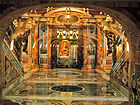 |
Gian Lorenzo Bernini Gian Lorenzo Bernini Gian Lorenzo Bernini was an Italian artist who worked principally in Rome. He was the leading sculptor of his age and also a prominent architect... (baldachin St. Peter's baldachin Saint Peter's baldachin is a large Baroque sculpted bronze canopy, technically called a ciborium or baldachin, over the high altar of Saint Peter's Basilica in the Vatican City, Rome, which is at the centre of the crossing and directly under the dome... ) |
St. Peter's Basilica St. Peter's Basilica The Papal Basilica of Saint Peter , officially known in Italian as ' and commonly known as Saint Peter's Basilica, is a Late Renaissance church located within the Vatican City. Saint Peter's Basilica has the largest interior of any Christian church in the world... |
See Saint Peter's tomb Saint Peter's tomb Saint Peter's tomb is a site under St. Peter's Basilica that includes several graves and a structure said by Vatican authorities to have been built to memorialize the location of St. Peter's grave. St. Peter's tomb is near the west end of a complex of mausoleums that date between about AD 130 and... |
| post42 / ante57–64/67(?) (as Bishop of Rome) |
2nd century
| Pontificate | Portrait | Common English name | Image | Sculptor | Location | Notes |
|---|---|---|---|---|---|---|
| 155–166 | 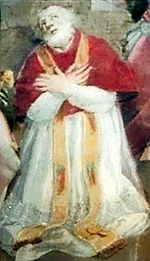 |
Anicetus Pope Anicetus Pope Saint Anicetus was Pope of the Catholic Church from about 150 to about 167 . His name is Greek for unconquered... Saint Anicetus |
Altemps Palace (Piazza Navona Piazza Navona Piazza Navona is a city square in Rome, Italy. It is built on the site of the Stadium of Domitian, built in 1st century AD, and follows the form of the open space of the stadium. The ancient Romans came there to watch the agones , and hence it was known as 'Circus Agonalis'... ) |
Remains translated from Vatican Hill to the Cemetery of Callixtus and possibly again thereafter; sarcophagus which may have once contained remains is extant in the Altemps Palace |
3rd century
| Pontificate | Portrait | Common English name | Image | Sculptor | Location | Notes |
|---|---|---|---|---|---|---|
| 25 June 253 – 5 March 254 |  |
Lucius I Pope Lucius I Pope Saint Lucius I was Pope from June 25, 253 to March 5, 254.St. Lucius was born in Rome at an unknown date; nothing is known about his family except his father's name, Porphyrianus. He was elected probably on June 25, 253, and died on March 5, 254... Saint Lucius |
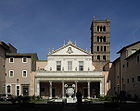 |
Santa Cecilia in Trastevere Santa Cecilia in Trastevere Santa Cecilia in Trastevere is a 5th century church in Rome, Italy, devoted to Saint Cecilia, in the Trastevere rione.-History:The first church on this site was founded probably in the 3rd century, by Pope Urban I; it was devoted to the Roman martyr Cecilia, martyred it is said under Marcus... |
Translated from the Catacomb of Callixtus Catacomb of Callixtus The Catacomb of Callixtus was one of the Catacombs of Rome on the Appian Way, most notable for containing the Crypt of the Popes , which contained the tombs of several popes from the 2nd to 4th centuries... to one or more of: Santa Cecilia in Trastevere, San Silvestro in Capite San Silvestro in Capite The Church of Saint Sylvester in Capite is a Roman Catholic minor basilica and titular church in Rome dedicated to Pope Saint Sylvester I. Built in the 8th century as a shrine for the relics of the saints and martyrs from the Catacombs, the church is the National church of Great Britain.The Latin... , and Santa Prassede Santa Prassede The Basilica of Saint Praxedes , commonly known in Italian as Santa Prassede, is an ancient titular church and minor basilica in Rome, Italy, located near the papal basilica of Saint Mary Major... ; sarcophagus that once held remains is extant in Santa Cecilia in Trastevere |
|
| 17 December 283 – 22 April 296 | 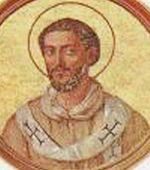 |
Caius Pope Caius Pope Saint Caius or Gaius was Pope from December 17, 283 to April 22, 296. Christian tradition makes him a native of the Dalmatian city of Salona, today Solin near Split, the son of a man also named Caius, and a member of a noble family related to the Emperor Diocletian.Little information on Caius... Saint Caius |
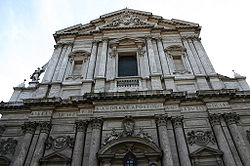 |
Sant'Andrea della Valle Sant'Andrea della Valle Sant'Andrea della Valle is a basilica church in Rome, Italy, in the rione of Sant'Eustachio. The basilica is the general seat for the religious order of the Theatines.-Overview:... (Barberini chapel) |
Translated from the crypt of St. Eusebius in the Cemetery of Callixtus to San Silvestre in Capite, then to another church, then to the private chapel of the Barberini Barberini The Barberini are a family of the Italian nobility that rose to prominence in 17th century Rome. Their influence peaked with the election of Cardinal Maffeo Barberini to the papal throne in 1623, as Pope Urban VIII... princes in Sant'Andrea della Valle Sant'Andrea della Valle Sant'Andrea della Valle is a basilica church in Rome, Italy, in the rione of Sant'Eustachio. The basilica is the general seat for the religious order of the Theatines.-Overview:... |
4th century
| Pontificate | Portrait | Common English name | Image | Sculptor | Location | Notes |
|---|---|---|---|---|---|---|
| 18 January 336 – 7 October 336 | .jpg) |
Mark Pope Mark Pope Saint Mark the apostle or Marcus was Pope from January 18, 336 to October 7, 336, date of his death.Little is known of his early life. According to the Liber Pontificalis, he was a Roman, and his father's name was Priscus... Saint Mark |
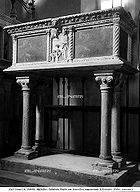 |
San Marco | Translated from the Catacomb of Balbina Balbina Memorials of St. Balbina are to be found at Rome in three different spots which are connected with the early Christian antiquities of that city. In the purely legendary account of the martyrdom of St. Alexander mention is made of a tribune Quirinus who died a martyr and was buried in the catacomb... , one of the Catacombs of Rome Catacombs of Rome The Catacombs of Rome are ancient catacombs, underground burial places under or near Rome, Italy, of which there are at least forty, some discovered only in recent decades. Though most famous for Christian burials, either in separate catacombs or mixed together, they began in the 2nd century, much... |
5th century
| Pontificate | Portrait | Common English name | Image | Sculptor | Location | Notes |
|---|---|---|---|---|---|---|
| 29 September 440 – 10 November 461 |  |
Leo I Pope Leo I Pope Leo I was pope from September 29, 440 to his death.He was an Italian aristocrat, and is the first pope of the Catholic Church to have been called "the Great". He is perhaps best known for having met Attila the Hun in 452, persuading him to turn back from his invasion of Italy... Saint Leo Leo the Great |
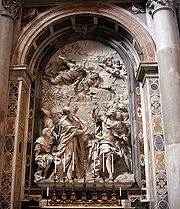 |
Alessandro Algardi Alessandro Algardi Alessandro Algardi was an Italian high-Baroque sculptor active almost exclusively in Rome, where for the latter decades of his life, he was the major rival of Gian Lorenzo Bernini.-Early years:... (relief) |
St. Peter's Basilica, Chapel of the Madonna of Partorienti | First pope buried on the porch of Old St. Peter's Basilica; translated multiple times, combined with Leos II, III, and IV circa 855; removed in the seventeenth century and placed under his own altar, below Algardi's relief, Fuga d'Attila (pictured) |
6th century
| Pontificate | Portrait | Common English name | Image | Sculptor | Location | Notes |
|---|---|---|---|---|---|---|
| 3 September 590 – 12 March 604 | 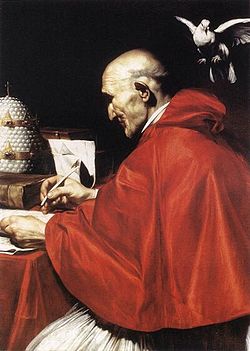 |
Gregory I Pope Gregory I Pope Gregory I , better known in English as Gregory the Great, was pope from 3 September 590 until his death... , O.S.B. Order of Saint Benedict The Order of Saint Benedict is a Roman Catholic religious order of independent monastic communities that observe the Rule of St. Benedict. Within the order, each individual community maintains its own autonomy, while the organization as a whole exists to represent their mutual interests... Saint Gregory Gregory the Great |
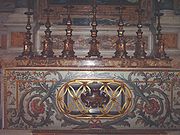 |
Unknown | St. Peter's Basilica | Originally buried in the portico of Old St. Peter's, partly transferred to Soissous; during the demolition of St. Peter's, transferred to Sant'Andrea della Valle Sant'Andrea della Valle Sant'Andrea della Valle is a basilica church in Rome, Italy, in the rione of Sant'Eustachio. The basilica is the general seat for the religious order of the Theatines.-Overview:... then Cappella Clementina, near the entrance of the modern St. Peter's |
7th century
| Pontificate | Portrait | Common English name | Image | Sculptor | Location | Notes |
|---|---|---|---|---|---|---|
| 13 September 604 – 22 February 606 |  |
Sabinian Pope Sabinian Pope Sabinian was pope from 604 to 606. He was born at Blera near Viterbo. Pope during the Byzantine Papacy, he was fourth former apocrisiarius to Constantinople elected pope.-Apokrisiariat :... Saint Sabinian |
Unknown | St. Peter's Basilica | Original monument in the atrium of Old St. Peter's destroyed during the demolition of Old St. Peter's; small fragment of the original epitaph remains in the crypt of St. Peter's Basilica | |
| 25 August 608 – 8 May 615 | Boniface IV Pope Boniface IV Pope Saint Boniface IV was pope from 608 to his death.Son of Johannes, a physician, a Marsian from the province and town of Valeria; he succeeded Boniface III after a vacancy of over nine months. He was consecrated on either 25 August or September 15 in 608... , O.S.B. Order of Saint Benedict The Order of Saint Benedict is a Roman Catholic religious order of independent monastic communities that observe the Rule of St. Benedict. Within the order, each individual community maintains its own autonomy, while the organization as a whole exists to represent their mutual interests... Saint Boniface |
Unknown | St. Peter's Baslica | Originally buried in the portico of Old St. Peter's; translated to the interior; one arm translated to Santa Maria in Cosmedin Santa Maria in Cosmedin The Basilica of Saint Mary in Cosmedin is a minor basilica church in Rome, Italy. It is located in the rione of Ripa.- History :The church was built in the 8th century during the Byzantine Papacy over the remains of the Templum Herculis Pompeiani in the Forum Boarium and of the Statio annonae, one... ; other relics translated to the Chapel of St. Sylvester beside the Church of the Quattro Coronati; remainder translated to another chapel of St. Peter's; oratory which once contained the tomb is extant, as well as a sketch of the tomb by Ciampini |
||
| December 681 – 3 July 683 | 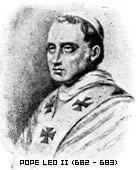 |
Leo II Pope Leo II -Background and early activity in the Church:He was a Sicilian by birth , and succeeded Agatho. Though elected pope a few days after the death of St. Agatho , he was not consecrated till after the lapse of a year and seven months... Saint Leo |
 |
Unknown | St. Peter's Basilica, Chapel of the Madonna of Partorienti | Originally buried in Old St. Peter's; translated under the altar of the Chapel of the Madonna della Colonna; combined with Leo I in the early seventeenth century; for centuries believed to be under the altar of the Church of San Stefano in Ferrara; combined remains of Leo's I, II, and IV found during the demolition of Old St. Peter's |
8th century
| Pontificate | Portrait | Common English name | Image | Sculptor | Location | Notes |
|---|---|---|---|---|---|---|
| 1 February 772 – 26 December 795 | 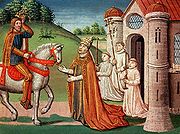 |
Adrian I Pope Adrian I Pope Adrian was pope from February 1, 772 to December 25, 795. He was the son of Theodore, a Roman nobleman.Shortly after Adrian's accession the territory ruled by the papacy was invaded by Desiderius, king of the Lombards, and Adrian was compelled to seek the assistance of the Frankish king... |
Unknown | St. Peter's Basilica | Original monument in the Oratory of Cathedra Petri destroyed during the demolition of Old St. Peter's; inscription, composed by Charlemagne Charlemagne Charlemagne was King of the Franks from 768 and Emperor of the Romans from 800 to his death in 814. He expanded the Frankish kingdom into an empire that incorporated much of Western and Central Europe. During his reign, he conquered Italy and was crowned by Pope Leo III on 25 December 800... , remains in the portico of modern St. Peter's |
|
| 26 December 795 – 12 June 816 | 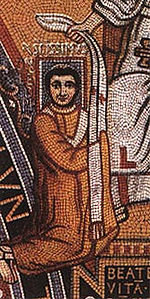 |
Leo III Pope Leo III Pope Saint Leo III was Pope from 795 to his death in 816. Protected by Charlemagne from his enemies in Rome, he subsequently strengthened Charlemagne's position by crowning him as Roman Emperor.... Saint Leo |
 |
Unknown | St. Peter's Basilica, Chapel of the Madonna of Partorienti | Originally buried in Old St. Peter's; combined with Leo II and IV by Pope Paschal II; combined sarcophagus destroyed during the demolition of Old St. Peter's; combined with Leo I in 1601 and placed in a sarcophagus under the altar of our Savior della Colonna in new St. Peter's |
9th century
| Pontificate | Portrait | Common English name | Image | Sculptor | Location | Notes |
|---|---|---|---|---|---|---|
| January 847 – 17 July 855 | 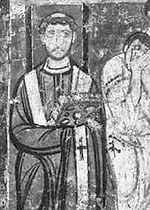 |
Leo IV Pope Leo IV Pope Saint Leo IV was pope from 10 April 847 to 17 July 855.A Roman by birth, he was unanimously chosen to succeed Sergius II. When he was elected, on 10 April 847, he was cardinal of Santi Quattro Coronati, and had been subdeacon of Gregory IV and archpriest under his predecessor... , O.S.B. Order of Saint Benedict The Order of Saint Benedict is a Roman Catholic religious order of independent monastic communities that observe the Rule of St. Benedict. Within the order, each individual community maintains its own autonomy, while the organization as a whole exists to represent their mutual interests... Saint Leo |
 |
Unknown | St. Peter's Basilica, Chapel of the Madonna of Partorienti | Combined with Leos I, II, and III |
| 24 April 858 – 13 November 867 |  |
Nicholas I Pope Nicholas I Pope Nicholas I, , or Saint Nicholas the Great, reigned from April 24, 858 until his death. He is remembered as a consolidator of papal authority and power, exerting decisive influence upon the historical development of the papacy and its position among the Christian nations of Western Europe.He... Saint Nicholas Nicholas the Great |
Unknown | St. Peter's Basilica | Originally buried in the atrium of Old St. Peter's; epitaph partially preserved during the demolition of Old St. Peter's, extant in the Vatican grottoes | |
| 14 December 867 – 14 December 872 | 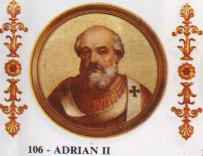 |
Adrian II Pope Adrian II Pope Adrian II , , pope from December 14, 867 to December 14, 872, was a member of a noble Roman family, and became pope in 867, at an advanced age.... |
Unknown | St. Peter's Basilica | Originally buried in Old St. Peter's; epitaph partially preserved during the demolition of Old St. Peter's, still visible in the Vatican grottoes | |
| 17 May 884 – c.September 885 | 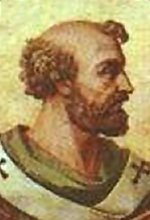 |
Adrian III Pope Adrian III Pope Saint Adrian III was Pope from May 17, 884 to September 885. He was born at Rome. He died in September 885, at San Cesario sul Panaro , on a journey to Worms, in modern Germany.... Saint Adrian |
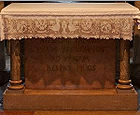 |
Unknown | Nonantola Abbey | Crypt altar |
10th century
| Pontificate | Portrait | Common English name | Image | Sculptor | Location | Notes |
|---|---|---|---|---|---|---|
| 22 May 964 – 23 June 964 | 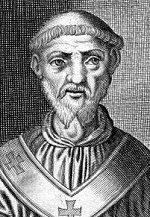 |
Benedict V Pope Benedict V Pope Benedict V , Pope in 964, was elected by the Romans on the death of Pope John XII . However the Holy Roman Emperor Otto I did not approve of the choice and had him deposed after only a month and the ex-Pope was carried off to Hamburg and was placed under the care of Adaldag, Archbishop of... |
Unknown | Hamburg Cathedral | Destroyed; possibly translated back to Old St. Peter's (but no trace has been found); cenotaph, not tomb, remains | |
| October 974 – 10 July 983 |  |
Benedict VII Pope Benedict VII Pope Benedict VII, born in Rome, the son of David or Deodatus , and previously Bishop of Sutri, died July 10, 983; belonged to the noble family of the Counts of Tusculum. He was elected by the Roman clergy and people under the influence of Sicco, imperial envoy of Emperor Otto II... |
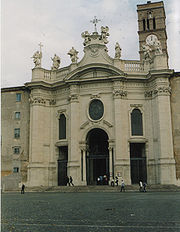 |
Unknown | Santa Croce in Gerusalemme Santa Croce in Gerusalemme The Basilica of the Holy Cross in Jerusalem is a Roman Catholic parish church and minor basilica in Rome, Italy. It is one of the Seven Pilgrim Churches of Rome.... |
Funerary inscription embedded in the wall near the entrance |
| 3 May 996 – 18 February 999 | 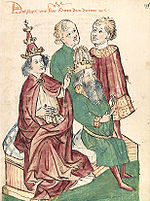 |
Gregory V Pope Gregory V Pope Gregory V, né Bruno of Carinthia , Pope from May 3, 996 to February 18, 999, son of the Salian Otto I, Duke of Carinthia, who was a grandson of the Emperor Otto I the Great . Gregory V succeeded Pope John XV , when only twenty-four years of age... |
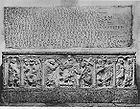 |
Unknown | St. Peter's Basilica | Tomb discovered on August 14, 1607 under the pavement of St. Peter's; exhumed and reburied on January 15, 1609 in a fourth/fifth century sarcophagus Early Christian sarcophagi Early Christian sarcophagi are those produced by the first Christians through to the 5th century, particularly known via 3rd century examples.... |
| 2 April 999 – 12 May 1003 |  |
Sylvester II | 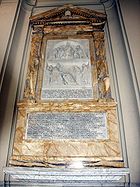 |
Gzila Nalder and Giuseppe Damko | Basilica of St. John Lateran | Destroyed in the Lateran fire of 1308; charred remains were collected and buried in a polyandrum in the same basilica; epitaph reingraved on a cenotaph in the same basilica; modern monument created in 1910 |
11th century
| Pontificate | Portrait | Common English name | Image | Sculptor | Location | Notes |
|---|---|---|---|---|---|---|
| 31 July 1009 – 12 May 1012 |  |
Sergius IV Pope Sergius IV Pope Sergius IV , born Pietro Martino Buccaporci, was Pope from July 31, 1009, until his death. The date of his birth is unknown. His birth name is believed to have been Pietro Martino Buccaporci... |
Francesco Borromini Francesco Borromini Francesco Borromini, byname of Francesco Castelli was an architect from Ticino who, with his contemporaries, Gian Lorenzo Bernini and Pietro da Cortona, was a leading figure in the emergence of Roman Baroque architecture.A keen student of the architecture of Michelangelo and the ruins of... |
Basilica of St. John Lateran Basilica of St. John Lateran The Papal Archbasilica of St. John Lateran , commonly known as St. John Lateran's Archbasilica and St. John Lateran's Basilica, is the cathedral of the Diocese of Rome and the official ecclesiastical seat of the Bishop of Rome, who is the Pope... |
Original destroyed in a fire in either 1308 or 1361; remains collected in a polyandrum in the same basilica; new cenotaph placed on the right side of the main nave by Borromini in the seventeenth century | |
| 24 December 1046 – 9 October 1047 | 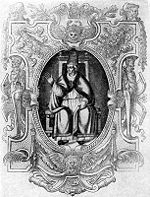 |
Clement II Pope Clement II Pope Clement II , was Pope from December 25, 1046 to his death. He was the first in a series of reform-minded popes from Germany.Born in Hornburg, Lower Saxony, Germany, he was the son of Count Konrad of Morsleben and Hornburg and his wife Amulrad.In 1040, he became Bishop of Bamberg... |
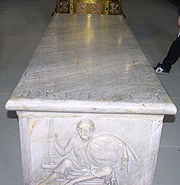 |
"Reims workshop" | Bamberg Cathedral Bamberg Cathedral The Bamberg Cathedral is a church in Bamberg, Germany, completed in the 13th century. The cathedral is under the administration of the Roman Catholic Church and is the seat of the Archbishop of Bamberg.... |
Only extant papal tomb outside of Italy and France; original completed circa 1237, dismantled in the seventeenth century, separating the tomb-chest and effigy; tomb-chest constructed with marble from Kärnten Carinthia (state) Carinthia is the southernmost Austrian state or Land. Situated within the Eastern Alps it is chiefly noted for its mountains and lakes.The main language is German. Its regional dialects belong to the Southern Austro-Bavarian group... |
| 17 July 1048 – 9 August 1048 |  |
Damasus II Pope Damasus II Pope Damasus II , born Poppo, Pope from July 17, 1048 to August 9, 1048, was the second of the German pontiffs nominated by Emperor Henry III . A native of Bavaria, he was the third German to become Pope and had one of the shortest papal reigns... |
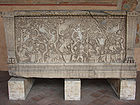 |
Unknown | San Lorenzo fuori le Mura San Lorenzo fuori le Mura The Papal Basilica of Saint Lawrence outside the Walls is a Roman Catholic parish church and minor basilica, located in Rome, Italy. The basilica is one of the Seven Pilgrim Churches of Rome and one of the five Patriarchal basilicas, each of which is assigned to a patriarchate. St... |
Sarcophagus in the portico |
| 12 February 1049 – 19 April 1054 |  |
Leo IX Pope Leo IX Pope Saint Leo IX , born Bruno of Eguisheim-Dagsburg, was Pope from February 12, 1049 to his death. He was a German aristocrat and as well as being Pope was a powerful secular ruler of central Italy. He is regarded as a saint by the Roman Catholic Church, with the feast day of April 19... Saint Leo |
Unknown | St. Peter's Basilica | Originally buried in the east wall of Old St. Peter's, close to the altar of Gregory I; coffin opened on January 11, 1606 during the demolition of Old St. Peter's and parts were taken as relics; remainder reburied under the altar of Saints Marziale and Valeria, now dedicated to the stigmata of St. Francis of Assisi | |
| 22 April 1073 – 25 May 1085 |  |
Gregory VII Pope Gregory VII Pope St. Gregory VII , born Hildebrand of Sovana , was Pope from April 22, 1073, until his death. One of the great reforming popes, he is perhaps best known for the part he played in the Investiture Controversy, his dispute with Henry IV, Holy Roman Emperor affirming the primacy of the papal... , O.S.B. Order of Saint Benedict The Order of Saint Benedict is a Roman Catholic religious order of independent monastic communities that observe the Rule of St. Benedict. Within the order, each individual community maintains its own autonomy, while the organization as a whole exists to represent their mutual interests... Saint Gregory |
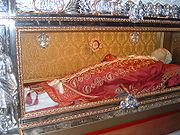 |
Unknown | Salerno Cathedral | Originally buried in the Church of St. Matthew; discovered in 1573, opened in 1578, reburied beneath the Salerno altar; opened again in 1605 (head taken to Cathedral of Soana; corpse translated to chapel of the Crociata); original sarcophagus placed in transept in 1954 |
| 24 May 1086 – 16 September 1087 |  |
Victor III Pope Victor III Pope Blessed Victor III , born Daufer , Latinised Dauferius, was the Pope as the successor of Pope Gregory VII, yet his pontificate is far less impressive in history than his time as Desiderius, the great Abbot of Monte Cassino.-Early life and abbacy:He was born in 1026 or 1027 of a non-regnant... , O.S.B. Order of Saint Benedict The Order of Saint Benedict is a Roman Catholic religious order of independent monastic communities that observe the Rule of St. Benedict. Within the order, each individual community maintains its own autonomy, while the organization as a whole exists to represent their mutual interests... Blessed Victor |
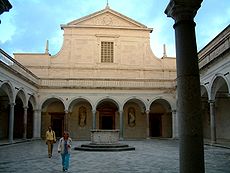 |
Unknown | Abbey of Monte Cassino Monte Cassino Monte Cassino is a rocky hill about southeast of Rome, Italy, c. to the west of the town of Cassino and altitude. St. Benedict of Nursia established his first monastery, the source of the Benedictine Order, here around 529. It was the site of Battle of Monte Cassino in 1944... |
Translated in 1515 to the altar in the chapel of St. Bertharius, then the chapel of St. Victor; transferred from Monte Cassino during World War II to San Polo fuori le Mura Basilica of Saint Paul Outside the Walls The Papal Basilica of St Paul Outside the Walls , commonly known as St Paul's Outside the Walls, is one of four churches that are the great ancient major basilicas or papal basilicas of Rome: the basilicas of St. John Lateran, St. Mary Major, and St. Peter's and Saint Paul Outside the Walls... , avoiding the aerial bombing Battle of Monte Cassino The Battle of Monte Cassino was a costly series of four battles during World War II, fought by the Allies against Germans and Italians with the intention of breaking through the Winter Line and seizing Rome.In the beginning of 1944, the western half of the Winter Line was being anchored by Germans... that destroyed the original chapel; returned to the rebuilt basilica of Monte Cassino in 1963 |
12th century
| Pontificate | Portrait | Common English name | Image | Sculptor | Location | Notes |
|---|---|---|---|---|---|---|
| 24 January 1118 – 28 January 1119 | 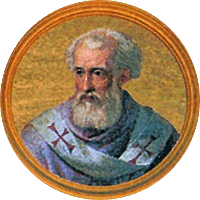 |
Gelasius II Pope Gelasius II Pope Gelasius II , born Giovanni Caetani , was pope from January 24, 1118 to January 29, 1119.-Biography:He was born between 1060 and 1064 at Gaeta into the Pisan branch of the Caetani family.... , O.S.B. Order of Saint Benedict The Order of Saint Benedict is a Roman Catholic religious order of independent monastic communities that observe the Rule of St. Benedict. Within the order, each individual community maintains its own autonomy, while the organization as a whole exists to represent their mutual interests... |
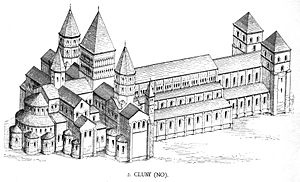 |
Unknown | Cluny Abbey Cluny Abbey Cluny Abbey is a Benedictine monastery in Cluny, Saône-et-Loire, France. It was built in the Romanesque style, with three churches built in succession from the 10th to the early 12th centuries.... |
Tuscan-style bright marble tomb destroyed in 1792 during the French Revolution French Revolution The French Revolution , sometimes distinguished as the 'Great French Revolution' , was a period of radical social and political upheaval in France and Europe. The absolute monarchy that had ruled France for centuries collapsed in three years... ; fragments remain |
| 14 February 1130 – 24 September 1143 | 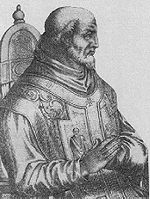 |
Innocent II Pope Innocent II Pope Innocent II , born Gregorio Papareschi, was pope from 1130 to 1143, and was probably one of the clergy in personal attendance on the antipope Clement III .-Early years:... , Can. Reg. Canons Regular Canons Regular are members of certain bodies of Canons living in community under the Augustinian Rule , and sharing their property in common... |
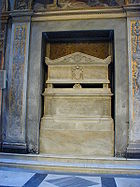 |
Vespignani (design) | Santa Maria in Trastevere Santa Maria in Trastevere The Basilica of Our Lady in Trastevere is a titular minor basilica, one of the oldest churches in Rome, and perhaps the first in which mass was openly celebrated... |
Originally buried in the porphyry sarcophagus of Emperor Hadrian Hadrian Hadrian , was Roman Emperor from 117 to 138. He is best known for building Hadrian's Wall, which marked the northern limit of Roman Britain. In Rome, he re-built the Pantheon and constructed the Temple of Venus and Roma. In addition to being emperor, Hadrian was a humanist and was philhellene in... in the Basilica of St. John Lateran; damaged during the fire of 1308 and moved to the vestibule; moved to a simple slab in the fifteenth century; moved to Santa Maria Trastevere |
| 8 July 1153 – 3 December 1154 | 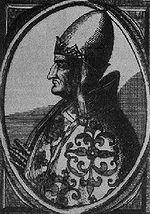 |
Anastasius IV Pope Anastasius IV Pope Anastasius IV , born Corrado Demetri della Suburra, was Pope from 1153 to 1154.-Early life:He was a Roman, son of Benedictus de Suburra, probably of the family of Demetri, and became a secular clerk. He was created cardinal-priest of S. Pudenziana by Pope Paschal II no later than in 1114... |
 |
Unknown | Vatican Museum | Reused the sarcophagus of Helena of Constantinople Helena of Constantinople Saint Helena also known as Saint Helen, Helena Augusta or Helena of Constantinople was the consort of Emperor Constantius, and the mother of Emperor Constantine I... , Constantine's mother; only tomb to survive the Lateran fires of 1308 and 1361 (restored fully in 1509); moved to the treasury of the Vatican Museum in the nineteenth century |
| 4 December 1154 – 1 September 1159 | 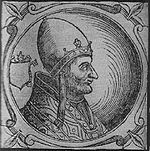 |
Adrian IV Pope Adrian IV Pope Adrian IV , born Nicholas Breakspear or Breakspeare, was Pope from 1154 to 1159.Adrian IV is the only Englishman who has occupied the papal chair... , O.S.A. Augustinians The term Augustinians, named after Saint Augustine of Hippo , applies to two separate and unrelated types of Catholic religious orders:... |
 |
Unknown | St. Peter's Basilica | Reused an Early Christian sarcophagus Early Christian sarcophagi Early Christian sarcophagi are those produced by the first Christians through to the 5th century, particularly known via 3rd century examples.... |
| 7 September 1159 – 30 August 1181 |  |
Alexander III Pope Alexander III Pope Alexander III , born Rolando of Siena, was Pope from 1159 to 1181. He is noted in history for laying the foundation stone for the Notre Dame de Paris.-Church career:... |
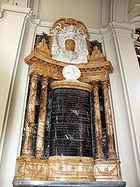 |
Francesco Borromini Francesco Borromini Francesco Borromini, byname of Francesco Castelli was an architect from Ticino who, with his contemporaries, Gian Lorenzo Bernini and Pietro da Cortona, was a leading figure in the emergence of Roman Baroque architecture.A keen student of the architecture of Michelangelo and the ruins of... |
Basilica of St. John Lateran | Ruined by mob graffiti and then destroyed in the Lateran fire of 1308 or 1361; new cenotph raised in seventeenth century |
| 1 September 1181 – 25 November 1185 | 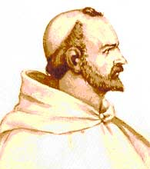 |
Lucius III Pope Lucius III Pope Lucius III , born Ubaldo, was pope from 1 September 1181 to his death.A native of the independent republic of Lucca, he was born ca. 1100 as Ubaldo, son of Orlando. He is commonly referred to as a member of the aristocratic family of Allucingoli, but this is not proven... |
Unknown | Verona Cathedral Verona Cathedral Verona Cathedral is a church in Verona, northern Italy.It was erected after two Palaeo-Christian churches on the same site had been destroyed by an earthquake in 1117. Built in Romanesque style, the cathedral was consecrated on September 13, 1187... |
Originally buried in a marble sarcophagus in front of the high altar; moved beneath the pavement under a red Veronese marble slab during the reign of bishop Gilberti (1524–1543); damaged during a storm on February 25, 1879; recovered with marble thereafter and original slab hung on the wall of the Cathedral | |
| 25 November 1185 – 19 October 1187 | 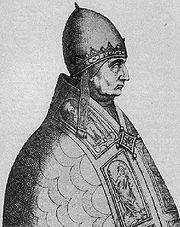 |
Urban III Pope Urban III Pope Urban III , born Uberto Crivelli, was Pope from 1185 to 1187. He was made cardinal and archbishop of Milan by Pope Lucius III, whom he succeeded on November 25, 1185... |
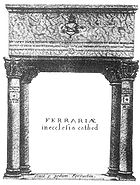 |
G.B. Boffa (modern cenotaph) | Ferrara Cathedral Ferrara Cathedral Ferrara Cathedral is a basilica in Ferrara, Northern Italy, the largest religious edifice in the city... |
Moved several times; original tomb replaced with cenotaph in fifteenth century |
| 8 January 1198 – 16 July 1216 | 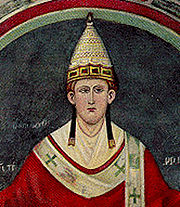 |
Innocent III Pope Innocent III Pope Innocent III was Pope from 8 January 1198 until his death. His birth name was Lotario dei Conti di Segni, sometimes anglicised to Lothar of Segni.... |
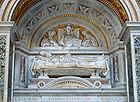 |
Giuseppe Lucchetti | Basilica of St. John Lateran | Originally buried in the Perugia Cathedral Perugia Cathedral The Cathedral of San Lorenzo is the main religious edifice of Perugia, Umbria, central Italy.- History :From the establishment of the bishopric, a cathedral existed in Perugia in different locations, until, in 936-1060, a new edifice, corresponding to the transept of the present cathedral, was... ; moved several times within the Cathedral, and temporarily combined with Urban IV and Martin IV, before being transferred to Basilica of St. John Lateran in 1891 |
13th century
| Pontificate | Portrait | Common English name | Image | Sculptor | Location | Notes |
|---|---|---|---|---|---|---|
| 25 June 1243 – 7 December 1254 | 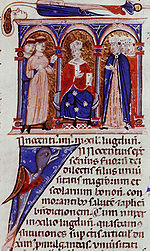 |
Innocent IV Pope Innocent IV Pope Innocent IV , born Sinibaldo Fieschi, was pope from June 25, 1243 until his death in 1254.-Early life:... |
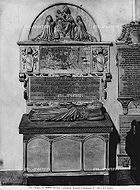 |
Unknown | Naples Cathedral | Original, commissioned by archbishop Humbert of Montauro, almost completely destroyed; the recumbent figure (with the anachronistic round top tiara) and above reliefs were added in the sixteenth century |
| 29 August 1261 – 2 October 1264 |  |
Urban IV Pope Urban IV Pope Urban IV , born Jacques Pantaléon, was Pope, from 1261 to 1264. He was not a cardinal, and there have been several Popes since him who have not been Cardinals, including Urban V and Urban VI.-Biography:... |
Giovanni Pisano Giovanni Pisano Giovanni Pisano was an Italian sculptor, painter and architect. Son of the famous sculptor Nicola Pisano, he received his training in the workshop of his father.... (original) |
Perugia Cathedral Perugia Cathedral The Cathedral of San Lorenzo is the main religious edifice of Perugia, Umbria, central Italy.- History :From the establishment of the bishopric, a cathedral existed in Perugia in different locations, until, in 936-1060, a new edifice, corresponding to the transept of the present cathedral, was... |
Destroyed in the late fourteenth century, save the epitaph which is currently in the Civic Museum of Perugia; combined with Innocent III and Martin IV in 1587 and interred in the sacristy; Innocent III's remains were transferred to John Lateran in the late nineteenth century, but the iron casket is still extant in the sacristy of the Perugia Cathedral; possibly translated to the Troyes Cathedral in 1901 | |
| 5 February 1265 – 29 November 1268 | 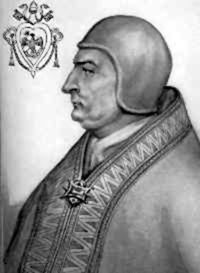 |
Clement IV Pope Clement IV Pope Clement IV , born Gui Faucoi called in later life le Gros , was elected Pope February 5, 1265, in a conclave held at Perugia that took four months, while cardinals argued over whether to call in Charles of Anjou, the youngest brother of Louis IX of France... |
Pietro Oderisi | San Francesco (Viterbo) | Translated from Santa Maria in Gradi | |
| 1 September 1271 – 10 January 1276 | 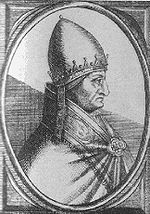 |
Gregory X Pope Gregory X Pope Blessed Gregory X , born Tebaldo Visconti, was Pope from 1271 to 1276. He was elected by the papal election, 1268–1271, the longest papal election in the history of the Roman Catholic Church.... Blessed Gregory |
Margaritone d'Arezzo Margaritone d'Arezzo Margarito or Margaritone d'Arezzo was an Italian painter from Arezzo.-Life:Little is known of Margaritone's life. The only documentary record of his existence dates from 1262, when he lived in Arezzo. However, a fair number of his works are known to survive; unusually for the time, most are signed... |
Arezzo Cathedral Arezzo Cathedral Arezzo Cathedral is a Roman Catholic cathedral in the city of Arezzo in Tuscany, Italy... |
Original body and sarcophagus are extant | |
| 11 July 1276 – 18 August 1276 |  |
Adrian V Pope Adrian V Pope Adrian V , born Ottobuono de' Fieschi, was pope in 1276.-Biography:Ottobuono belonged to a feudal family of Liguria, the Fieschi, Counts of Lavagna.... |
 |
Arnolfo di Cambio Arnolfo di Cambio Arnolfo di Cambio was an Italian architect and sculptor.-Biography:Arnolfo was born in Colle Val d'Elsa, Tuscany.... (possibly Pietro Vassalletto Pietro Vassalletto Pietro Vassalletto was an Italian sculptor from a family of artists active in Rome during the 12th-14th centuries.Among his work is the sculpture of the Easter Candlestick at the Basilica of Saint Paul Outside the Walls in Rome.... ) |
San Francesco (Viterbo) | Modified in 1994 |
| 8 September 1276 – 20 May 1277 | 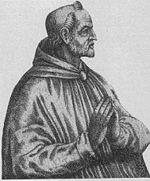 |
John XXI Pope John XXI Pope John XXI, , born Pedro Julião Pope John XXI, , born Pedro Julião Pope John XXI, , born Pedro Julião (Latin, Petrus Iulianus (c. 1215 – May 20, 1277), a Portuguese also called Pedro Hispano (Latin, Petrus Hispanus; English, Peter of Spain), was Pope from 1276 until his death about eight... |
Filippo Gnaccarini | Viterbo Cathedral | Original destroyed in the sixteenth century, no longer extant; new monument constructed in the 19th century and damaged during World War II, of which a sarcophagus and other fragments remain | |
| 25 November 1277 – 22 August 1280 | 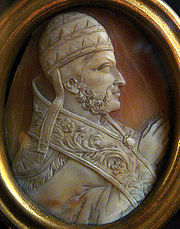 |
Nicholas III Pope Nicholas III Pope Nicholas III , born Giovanni Gaetano Orsini, Pope from November 25, 1277 to his death in 1280, was a Roman nobleman who had served under eight Popes, been made cardinal-deacon of St... |
 |
Unknown | St. Peter's Basilica | Original destroyed during the demolition of Old St. Peter's; combined with two Rainaldo Orsinis in 1620 |
| 22 February 1281 – 28 March 1285 | 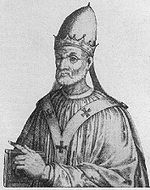 |
Martin IV Pope Martin IV Pope Martin IV, born Simon de Brion held the papacy from February 21, 1281 until his death.... |
Giovanni Pisano Giovanni Pisano Giovanni Pisano was an Italian sculptor, painter and architect. Son of the famous sculptor Nicola Pisano, he received his training in the workshop of his father.... |
Perugia Cathedral Perugia Cathedral The Cathedral of San Lorenzo is the main religious edifice of Perugia, Umbria, central Italy.- History :From the establishment of the bishopric, a cathedral existed in Perugia in different locations, until, in 936-1060, a new edifice, corresponding to the transept of the present cathedral, was... |
Original tomb destroyed by 1375; reconstructed and redestroyed by the end of the fourteenth century; combined with Popes Urban IV and Innocent III in 1587; Innocent III's remains were transferred to John Lateran in the late nineteenth century, but the iron casket containing Martin IV and possibly Urban IV is still extant in the sacristy of the Perugia Cathedral | |
| 2 April 1285 – 3 April 1287 |  |
Honorius IV Pope Honorius IV Pope Honorius IV , born Giacomo Savelli, was Pope for two years from 1285 to 1287. During his unremarkable pontificate he largely continued to pursue the pro-French policy of his predecessor, Pope Martin IV... |
 |
Arnolfo di Cambio Arnolfo di Cambio Arnolfo di Cambio was an Italian architect and sculptor.-Biography:Arnolfo was born in Colle Val d'Elsa, Tuscany.... |
Santa Maria in Aracoeli Santa Maria in Aracoeli The Basilica of St. Mary of the Altar of Heaven is a titular basilica in Rome, located on the highest summit of the Campidoglio. It is still the designated Church of the city council of Rome, which uses the ancient title of Senatus Populusque Romanus... |
Original destroyed early in the demolition of Old St. Peter's; baldecchio destroyed and replaced in 1727 |
| 22 February 1288 – 4 April 1292 | 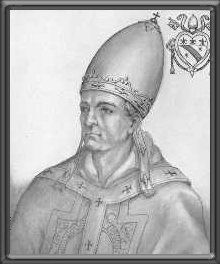 |
Nicholas IV Pope Nicholas IV Pope Nicholas IV , born Girolamo Masci, was Pope from February 22, 1288 to April 4, 1292. A Franciscan friar, he had been legate to the Greeks under Pope Gregory X in 1272, succeeded Bonaventure as Minister General of his religious order in 1274, was made Cardinal Priest of Santa Prassede and... , O.F.M. Franciscan Most Franciscans are members of Roman Catholic religious orders founded by Saint Francis of Assisi. Besides Roman Catholic communities, there are also Old Catholic, Anglican, Lutheran, ecumenical and Non-denominational Franciscan communities.... |
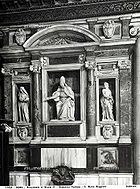 |
Domenico Fontana Domenico Fontana Domenico Fontana was a Swiss-born Italian architect of the late Renaissance.-Biography:200px|thumb|Fountain of Moses in Rome.... (design) Leonardo da Sarzana (sculptor) Leonardo Sormani Leonardo Sormani Leonardo Sormani was an Italian sculptor of secondary reputation, originally from Savona, who is recorded as living in Rome from the 1550s until about 1590... (figures) |
Basilica di Santa Maria Maggiore | Originally buried in a simple urn; mausoleum commissioned in the late sixteenth century |
| 5 July 1294 – 13 December 1294 |  |
Celestine V Pope Celestine V Pope Saint Celestine V, born Pietro Angelerio , also known as Pietro da Morrone was elected pope in the year 1294, by the papal election of 1292–1294, the last non-conclave in the history of the Roman Catholic Church... , O.S.B. Order of Saint Benedict The Order of Saint Benedict is a Roman Catholic religious order of independent monastic communities that observe the Rule of St. Benedict. Within the order, each individual community maintains its own autonomy, while the organization as a whole exists to represent their mutual interests... Saint Celestine |
 |
Girolama da Vicenza | Santa Maria di Collemaggio Santa Maria di Collemaggio S. Maria di Collemaggio is a large medieval church in L'Aquila, central Italy. It was the site of the original Papal Jubilee, a penitential observation devised by Pope Celestine V, who is buried here... (L'Aquila) |
Originally buried in Church of St. Anthony; moved to Church of St. Agatha; stolen in 1327 by L'Aquilan friars; damaged in the 2009 L'Aquila earthquake 2009 L'Aquila earthquake The 2009 L'Aquila earthquake occurred in the region of Abruzzo, in central Italy. The main shock occurred at 3:32 local time on 6 April 2009, and was rated 5.8 on the Richter scale and 6.3 on the moment magnitude scale; its epicentre was near L'Aquila, the capital of Abruzzo, which together... |
| 24 December 1294 – 11 October 1303 |  |
Boniface VIII Pope Boniface VIII Pope Boniface VIII , born Benedetto Gaetani, was Pope of the Catholic Church from 1294 to 1303. Today, Boniface VIII is probably best remembered for his feuds with Dante, who placed him in the Eighth circle of Hell in his Divina Commedia, among the Simonists.- Biography :Gaetani was born in 1235 in... |
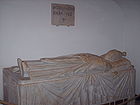 |
Unknown | St. Peter's Basilica | Original tomb chapel, into which Boniface VIII had moved the relics of Boniface IV, destroyed |
14th century
| Pontificate | Portrait | Common English name | Image | Sculptor | Location | Notes |
|---|---|---|---|---|---|---|
| 22 October 1303 – 7 July 1304 | 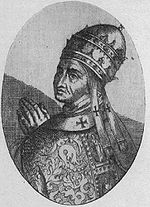 |
Benedict XI Pope Benedict XI Blessed Pope Benedict XI , born Nicola Boccasini, was Pope from 1303 to 1304.Born in Treviso, he succeeded Pope Boniface VIII , but was unable to carry out his policies... , O.P. Dominican Order The Order of Preachers , after the 15th century more commonly known as the Dominican Order or Dominicans, is a Catholic religious order founded by Saint Dominic and approved by Pope Honorius III on 22 December 1216 in France... Blessed Benedict |
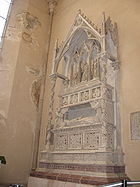 |
Giovanni Pisano Giovanni Pisano Giovanni Pisano was an Italian sculptor, painter and architect. Son of the famous sculptor Nicola Pisano, he received his training in the workshop of his father.... |
Basilica of San Domenico (Perugia) | Wall tomb and ossuary Ossuary An ossuary is a chest, building, well, or site made to serve as the final resting place of human skeletal remains. They are frequently used where burial space is scarce. A body is first buried in a temporary grave, then after some years the skeletal remains are removed and placed in an ossuary... |
| 5 June 1305 – 20 April 1314 | 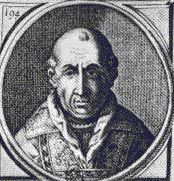 |
Clement V Pope Clement V Pope Clement V, born Raymond Bertrand de Got was Pope from 1305 to his death... |
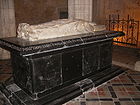 |
Jehan de Bonneval | Collegiate church Collegiate church In Christianity, a collegiate church is a church where the daily office of worship is maintained by a college of canons; a non-monastic, or "secular" community of clergy, organised as a self-governing corporate body, which may be presided over by a dean or provost... (Uzeste Uzeste Uzeste is a commune in the Gironde department in Aquitaine in southwestern France.-Population:-References:*... ) |
|
| 7 August 1316 – 4 December 1334 |  |
John XXII Pope John XXII Pope John XXII , born Jacques Duèze , was pope from 1316 to 1334. He was the second Pope of the Avignon Papacy , elected by a conclave in Lyon assembled by Philip V of France... |
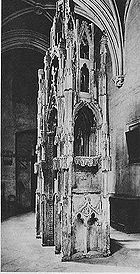 |
Unknown | Avignon Cathedral | Moved several times within the Cathedral's chapels; all 60 statuettes have been stolen, head of effigy is originally from another bishop's tomb; damaged badly during French Revolution French Revolution The French Revolution , sometimes distinguished as the 'Great French Revolution' , was a period of radical social and political upheaval in France and Europe. The absolute monarchy that had ruled France for centuries collapsed in three years... |
| 20 December 1334 – 25 April 1342 | 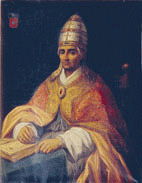 |
Benedict XII Pope Benedict XII Pope Benedict XII , born Jacques Fournier, the third of the Avignon Popes, was Pope from 1334 to 1342.-Early life:... , O.Cist. |
 |
Jean Lavenier | Avignon Cathedral | Bust of Benedict XII in the St. Peter's Basilica grottoes; fragments of original in Fondation Calvet Fondation Calvet La Fondation Calvet is an art foundation in Avignon, France, named for Esprit Calvet, who left his collections and library to it in 1810. The foundation maintains a museum and a library, with state support... |
| 7 May 1342 – 6 December 1352 | 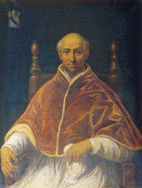 |
Clement VI Pope Clement VI Pope Clement VI , bornPierre Roger, the fourth of the Avignon Popes, was pope from May 1342 until his death in December of 1352... |
 |
Pierre Boye, Jean Sanholis, and Jean David | Abbey of La Chaise-Dieu La Chaise-Dieu La Chaise-Dieu is commune in the Haute-Loire department in south-central France.-Geography:La Chaise-Dieu occupies a 1082 m butte which dominates a plain between the mounts of Livradois and Velay... |
Sculpted weepers in Musée Crozatier, Le Puy; sculpted angel in Musée de Petit-Palais, Avignon |
| 18 December 1352 – 12 September 1362 | 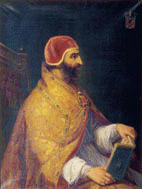 |
Innocent VI Pope Innocent VI Pope Innocent VI , born Étienne Aubert; his father was Adhemar Aubert seigneur de Montel-De-Gelas in Limousin province. His niece was Catherine Aubert, Dame de Boutheon, also the wife of Randon II baron de Joyeuse; she is La Fayette's ancestor... |
 |
Beltran Nogayrol | Chartreuse du Val de Bénédiction (Villeneuve-lès-Avignon Villeneuve-lès-Avignon Villeneuve-lès-Avignon is a commune in the Gard department in southern France. It can also be spelled Villeneuve-lez-Avignon.-Population:-Sights:* Chartreuse Notre-Dame-du-val-de-Bénédiction* Fort Saint-André* Tour Philippe Le Bel... ) |
|
| 28 September 1362 – 19 December 1370 | 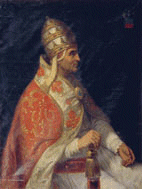 |
Urban V Pope Urban V Pope Urban V , born Guillaume Grimoard, was Pope from 1362 to 1370.-Biography:Grimoard was a native of Grizac in Languedoc . He became a Benedictine and a doctor in Canon Law, teaching at Montpellier and Avignon... , O.S.B. Order of Saint Benedict The Order of Saint Benedict is a Roman Catholic religious order of independent monastic communities that observe the Rule of St. Benedict. Within the order, each individual community maintains its own autonomy, while the organization as a whole exists to represent their mutual interests... Blessed Urban |
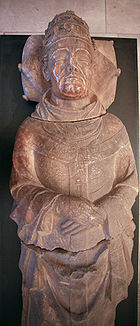 |
Joglarii | Abbey of St. Victor (Marseille) | Effigy in Musée de Petit-Palais, Avignon |
| 30 December 1370 – 26 March 1378 | 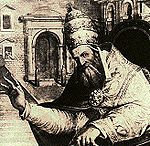 |
Gregory XI Pope Gregory XI Gregory XI was pope from 1370 until his death.-Biography:He was born Pierre Roger de Beaufort, in Maumont, in the modern commune of Rosiers-d'Égletons, Limousin around 1336. He succeeded Pope Urban V in 1370, and was pope until 1378... |
 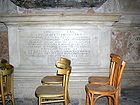 |
Pietro Paolo Olivieri | Santa Francesca Romana Santa Francesca Romana Santa Francesca Romana, previously known as Santa Maria Nova, is a church in Rome, Italy, situated next to the Roman Forum.- History :... |
Original Olivieri relief carved in 1584 (drawing above); replica located in Palais des Papes Palais des Papes The Palais des Papes is a historical palace in Avignon, southern France, one of the largest and most important medieval Gothic buildings in Europe.... |
| 8 April 1378 – 15 October 1389 |  |
Urban VI Pope Urban VI Pope Urban VI , born Bartolomeo Prignano, was Pope from 1378 to 1389.-Biography:Born in Itri, he was a devout monk and learned casuist, trained at Avignon. On March 21, 1364, he was consecrated Archbishop of Acerenza in the Kingdom of Naples... |
 |
Unknown | St. Peter's Basilica | Saved during the deconstruction of Old St. Peter's; nearly dumped by workmen for use as a water trough |
15th century
| Pontificate | Portrait | Common English name | Image | Sculptor | Location | Notes |
|---|---|---|---|---|---|---|
| 17 October 1404 – 6 November 1406 | 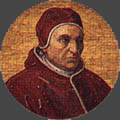 |
Innocent VII Pope Innocent VII Pope Innocent VII , born Cosimo de' Migliorati, was briefly Pope at Rome, from 1404 to his death, during the Western Schism while there was a rival Pope, antipope Benedict XIII , at Avignon.Migliorati was born to a simple family of Sulmona in the Abruzzi... |
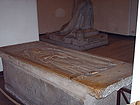 |
Unknown | St. Peter's Basilica | Originally buried in the Chapel of Saints Peter and Paul, moved to the Chapel of St. Thomas in 1455, moved into a mid-fifteenth century copy of the original sarcophagus on September 12, 1606 |
| 30 November 1406 – 4 July 1415 |  |
Gregory XII Pope Gregory XII Pope Gregory XII , born Angelo Correr or Corraro, Pope from 1406 to 1415, succeeded Pope Innocent VII on 30 November 1406.... |
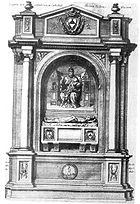 |
Camillo Rusconi Camillo Rusconi Camillo Rusconi was an Italian sculptor of the late Baroque in Rome. His style displays both features of Baroque and Neoclassicism. He has been described as a Carlo Maratta in marble.-Biography:... |
San Flaviano (Recanati Recanati Recanati is a town and comune in the Province of Macerata, Marche region of Italy. Recanati was founded around 1150 AD from three pre-existing castles. In 1290 it proclaimed itself an independent republic and, in the 15th century, was famous for its international fair... ) |
Cardinal at the time of his death, due to his resignation during the Council of Constance Council of Constance The Council of Constance is the 15th ecumenical council recognized by the Roman Catholic Church, held from 1414 to 1418. The council ended the Three-Popes Controversy, by deposing or accepting the resignation of the remaining Papal claimants and electing Pope Martin V.The Council also condemned and... ; Moved in 1623, 1760, and 1793; illustrations of an "original" tomb (pictured) have been deemed fabrications by historians; last papal tomb outside Rome (c.f. Tomb of Antipope John XXIII Tomb of Antipope John XXIII The Tomb of Antipope John XXIII is the marble and bronze tomb monument of Antipope John XXIII , created by Donatello and Michelozzo for the Florence Baptistry adjacent to the Duomo... ); original sarcophagus extant |
| 11 November 1417 – 20 February 1431 |  |
Martin V Pope Martin V Pope Martin V , born Odo Colonna, was Pope from 1417 to 1431. His election effectively ended the Western Schism .-Biography:... |
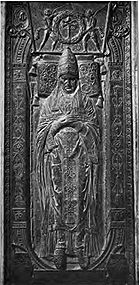 |
Simone Ghini Simone Ghini Simone Ghini, also known as Simone Ghini I and as Simone I di Giovanni di Simone Ghini, was an Italian renaissance sculptor who was born in 1406 or 1407. He is best-known for his funeral monument to Pope Martin V, in the Basilica of St. John Lateran, in Rome. Together with Antonio Filarete,... |
Basilica of St. John Lateran Basilica of St. John Lateran The Papal Archbasilica of St. John Lateran , commonly known as St. John Lateran's Archbasilica and St. John Lateran's Basilica, is the cathedral of the Diocese of Rome and the official ecclesiastical seat of the Bishop of Rome, who is the Pope... |
Moved in front of the high altar in 1853 |
| 3 March 1431 – 23 February 1447 | 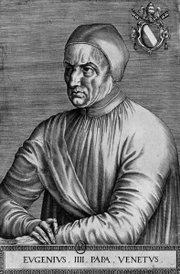 |
Eugene IV Pope Eugene IV Pope Eugene IV , born Gabriele Condulmer, was pope from March 3, 1431, to his death.-Biography:He was born in Venice to a rich merchant family, a Correr on his mother's side. Condulmer entered the Order of Saint Augustine at the monastery of St. George in his native city... , O.S.A. Augustinians The term Augustinians, named after Saint Augustine of Hippo , applies to two separate and unrelated types of Catholic religious orders:... |
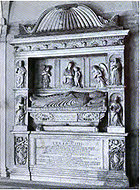 |
Iaia da Piso and Pellegrino di Antonio da Viterbo | San Salvatore in Lauro San Salvatore in Lauro San Salvatore in Lauro is a Catholic church in central Rome, Italy, located in the rione Ponte. It is the "national church" of the marchigiani, the inhabitants of the Marche region of Italy... |
Moved out of Old St. Peter's before its demolition |
| 6 March 1447 – 24 March 1455 |  |
Nicholas V Pope Nicholas V Pope Nicholas V , born Tommaso Parentucelli, was Pope from March 6, 1447 to his death in 1455.-Biography:He was born at Sarzana, Liguria, where his father was a physician... , O.P. Dominican Order The Order of Preachers , after the 15th century more commonly known as the Dominican Order or Dominicans, is a Catholic religious order founded by Saint Dominic and approved by Pope Honorius III on 22 December 1216 in France... |
 |
Mino da Fiesole Mino da Fiesole Mino da Fiesole , also known as Mino di Giovanni, was an Italian sculptor from Poppi, Tuscany. He is noted for his portrait busts.-Career:... |
St. Peter's Basilica | Moved from the left outer aisle of Old St. Peter's to the right outer aisle, but still monument (not sarcophagus) destroyed during the demolition of Old St. Peter's |
| 8 April 1455 – 6 August 1458 | 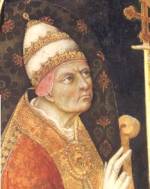 |
Callixtus III Pope Callixtus III Pope Callixtus III , né Alfons de Borja, was Pope from April 8, 1455 to his death in 1458.-Biography:... |
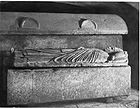 |
Unknown | St. Peter's Basilica | Originally located in Chapel of St. Mary della febbre; monument, but not sarcophagus, destroyed during the demolition of Old St. Peter's |
 |
Filippio Moratilla | Santa Maria in Monserrato Santa Maria in Monserrato degli Spagnoli The Spanish National Church of Santiago and Montserrat, known as Church of Holy Mary in Monserrat of the Spaniards is a Roman Catholic titulus church and National Church in Rome of Spain, dedicated to the Virgin of Montserrat. The current Cardinal Priest of the Titulus S... |
Remains later combined with Alexander VI | |||
| 19 August 1458 – 15 August 1464 | 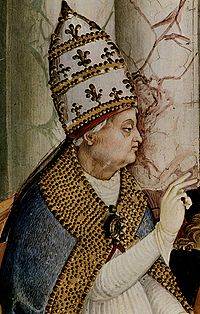 |
Pius II Pope Pius II Pope Pius II, born Enea Silvio Piccolomini was Pope from August 19, 1458 until his death in 1464. Pius II was born at Corsignano in the Sienese territory of a noble but decayed family... |
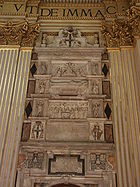 |
Paolo Romano Paolo Romano Paolo Romano , also known as Paolo Tuccone and as Paolo di Mariano di Tuccio Taccone was an Italian renaissance sculptor... |
Sant'Andrea della Valle Sant'Andrea della Valle Sant'Andrea della Valle is a basilica church in Rome, Italy, in the rione of Sant'Eustachio. The basilica is the general seat for the religious order of the Theatines.-Overview:... |
Heart enshrined in the Duomo of Ancona; originally buried in the Chapel of St. Andrews in St. Peter's; moved to San Andrea della Valle in 1614 |
| 30 August 1464 – 26 July 1471 |  |
Paul II Pope Paul II Pope Paul II , born Pietro Barbo, was pope from 1464 until his death in 1471.- Early life :He was born in Venice, and was a nephew of Pope Eugene IV , through his mother. His adoption of the spiritual career, after having been trained as a merchant, was prompted by his uncle's election as pope... |
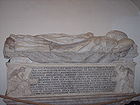 |
Giovanni Dalmata (effigy) Mino da Fiesole Mino da Fiesole Mino da Fiesole , also known as Mino di Giovanni, was an Italian sculptor from Poppi, Tuscany. He is noted for his portrait busts.-Career:... (figures and bas-reliefs) |
St. Peter's Basilica | Monument moved in 1544 and torn down in seventeenth century; sarcophagus survived demolition of Old St. Peter's |
| 9 August 1471 – 12 August 1484 | 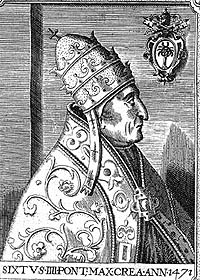 |
Sixtus IV Pope Sixtus IV Pope Sixtus IV , born Francesco della Rovere, was Pope from 1471 to 1484. His accomplishments as Pope included the establishment of the Sistine Chapel; the group of artists that he brought together introduced the Early Renaissance into Rome with the first masterpiece of the city's new artistic age,... , O.F.M. Franciscan Most Franciscans are members of Roman Catholic religious orders founded by Saint Francis of Assisi. Besides Roman Catholic communities, there are also Old Catholic, Anglican, Lutheran, ecumenical and Non-denominational Franciscan communities.... |
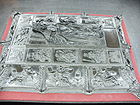 |
Antonio del Pollaiolo | St. Peter's Basilica | Originally located in the choir chapel of Old St. Peter's; moved in 1610 to the sacristy; moved in 1625 to the Chapel del Coro in new St. Peter's; combined with Julius II in 1926; moved again in 1940s |
| 29 August 1484 – 25 July 1492 | 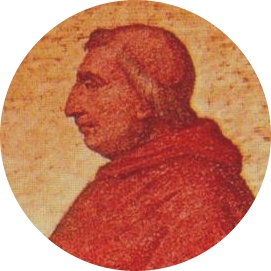 |
Innocent VIII Pope Innocent VIII Pope Innocent VIII , born Giovanni Battista Cybo , was Pope from 1484 until his death.-Early years:Giovanni Battista Cybo was born at Genoa of Greek extraction... |
 |
Antonio del Pollaiolo | St. Peter's Basilica | First papal tomb to depict a live pope rather than a deathbed effigy; originally placed in the Oratory of Our Lady in Old St. Peter's; moved to the sudarium on 5 September 1606 during the demolition |
| 11 August 1492 – 18 August 1503 | 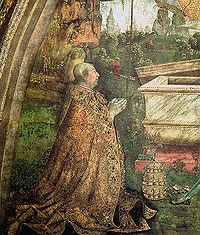 |
Alexander VI Pope Alexander VI Pope Alexander VI , born Roderic Llançol i Borja was Pope from 1492 until his death on 18 August 1503. He is one of the most controversial of the Renaissance popes, and his Italianized surname—Borgia—became a byword for the debased standards of the Papacy of that era, most notoriously the Banquet... |
 |
Filippio Moratilla | Santa Maria di Monserrato Santa Maria in Monserrato degli Spagnoli The Spanish National Church of Santiago and Montserrat, known as Church of Holy Mary in Monserrat of the Spaniards is a Roman Catholic titulus church and National Church in Rome of Spain, dedicated to the Virgin of Montserrat. The current Cardinal Priest of the Titulus S... |
Originally located in the oratory of Saints Cosmas and Damian, in the round chapel of Santa Maria de Febribus; moved in the sixteenth century next to Calixtus III; combined in 1582 in the Chapel of Santa Maria della Febbre; survived demolition of Old St. Peter's but broken up in 1605; urns were taken to Santa Maria di Monserrato; monument in Chapel of St. Diego sculpted in 1881 |
16th century
| Pontificate | Portrait | Common English name | Image | Sculptor | Location | Notes |
|---|---|---|---|---|---|---|
| 22 September 1503 – 18 October 1503 |  |
Pius III Pope Pius III Pope Pius III , born Francesco Todeschini Piccolomini, was Pope from September 22 to October 18, 1503.-Career:... |
 |
Unknown | St. Peter's Basilica | Originally built in Old St. Peter's; last papal mausoleum erected in Old St. Peter's |
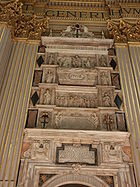 |
Sebastiano Ferrucci | Sant'Andrea della Valle Sant'Andrea della Valle Sant'Andrea della Valle is a basilica church in Rome, Italy, in the rione of Sant'Eustachio. The basilica is the general seat for the religious order of the Theatines.-Overview:... |
Moved to Sant'Andrea della Valle by Paul V | |||
| 31 October 1503 – 21 February 1513 | Julius II Pope Julius II Pope Julius II , nicknamed "The Fearsome Pope" and "The Warrior Pope" , born Giuliano della Rovere, was Pope from 1503 to 1513... , O.F.M. Franciscan Most Franciscans are members of Roman Catholic religious orders founded by Saint Francis of Assisi. Besides Roman Catholic communities, there are also Old Catholic, Anglican, Lutheran, ecumenical and Non-denominational Franciscan communities.... |
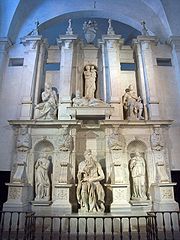 |
Michelangelo Michelangelo Michelangelo di Lodovico Buonarroti Simoni , commonly known as Michelangelo, was an Italian Renaissance painter, sculptor, architect, poet, and engineer who exerted an unparalleled influence on the development of Western art... Possible assistants include: Antonello Gagini Antonello Gagini Antonello Gagini was an Italian sculptor of the Renaissance, mainly active in Sicily and Calabria.Antonello was a member of a family of sculptors and artisans, originally from Northern Italy, but active throughout Italy, including Genoa, Florence, and Rome. The family includes his father, Domenico... Giacomo del Duca Giacomo del Duca Giacomo Del Duca was an Italian sculptor and architect during the late-Renaissance or Mannerist period... |
San Pietro in Vincoli San Pietro in Vincoli San Pietro in Vincoli is a Roman Catholic titular church and minor basilica in Rome, Italy, best known for being the home of Michelangelo's statue of Moses, part of the tomb of Pope Julius II.-History:... |
Original, planned tomb—intended for the Cappella Maggiore of St. Peter's—never completed and moved to San Pietro in Vincolo See Moses Moses (Michelangelo) The Moses is a sculpture by the Italian High Renaissance artist Michelangelo Buonarroti, housed in the church of San Pietro in Vincoli in Rome... and Dying Slave Dying Slave The Dying Slave is a sculpture by the Italian Renaissance artist Michelangelo. Created between 1513 and 1516, it was to serve with another figure, the Rebellious Slave, at the tomb of Pope Julius II. It is a marble figure 2.28 metres in height, and is held at the Louvre, Paris.The man's left wrist... |
|
| Unknown | St. Peter's Basilica | Actual remains deposited in a simple sarcophagus, combined with Sixtus IV, his uncle | ||||
| 9 March 1513 – 1 December 1521 |  |
Leo X Pope Leo X Pope Leo X , born Giovanni di Lorenzo de' Medici, was the Pope from 1513 to his death in 1521. He was the last non-priest to be elected Pope. He is known for granting indulgences for those who donated to reconstruct St. Peter's Basilica and his challenging of Martin Luther's 95 Theses... |
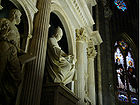 |
Baccio Bandinelli (design) Antonio da Sangallo the Younger Antonio da Sangallo the Younger thumb|250px|The church of Santa Maria di Loreto near the [[Trajan's Market]] in [[Rome]], considered Sangallo's masterwork.thumb|250px|View of St. Patrick's Well in [[Orvieto]].... (monument) Raffaello da Montelupo Raffaello da Montelupo Raffaello da Montelupo , born Raffaele Sinibaldi, was a sculptor and architect of the Italian Renaissance, and an apprentice of Michelangelo. He was the son of another Italian sculptor, Baccio da Montelupo... (statue) |
Santa Maria sopra Minerva Santa Maria sopra Minerva The Basilica of Saint Mary Above Minerva is a titular minor basilica and one of the most important churches of the Roman Catholic Dominican order in Rome, Italy. The church, located in the Piazza della Minerva in the Campus Martius region, is considered the only Gothic church in Rome. It houses... |
Translated from Old St. Peter's in 1536 |
| 9 January 1522 – 14 September 1523 |  |
Adrian VI Pope Adrian VI Pope Adrian VI , born Adriaan Florenszoon Boeyens, served as Pope from 9 January 1522 until his death some 18 months later... |
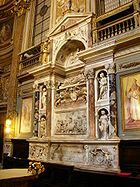 |
Baldassare Peruzzi Baldassare Peruzzi Baldassare Tommaso Peruzzi was an Italian architect and painter, born in a small town near Siena and died in Rome. He worked for many years, beginning in 1520, under Bramante, Raphael, and later Sangallo during the erection of the new St. Peter's... (design) Michelangelo of Sieno and Niccolò Tribolo Niccolò Tribolo Niccolò di Raffaello di Niccolò dei Pericoli, called "Il Tribolo" was an Italian Mannerist artist in the service of Cosimo I de' Medici in his natal city of Florence.-Life:... (carved) |
Santa Maria dell'Anima Santa Maria dell'Anima Santa Maria dell'Anima is a Roman Catholic church in central Rome, Italy, just west of the Piazza Navona and near the Santa Maria della Pace church. It was the national church of the Holy Roman Empire in Rome... |
Translated from Old St. Peter's in 1533 to the national church of the Holy Roman Empire Holy Roman Empire The Holy Roman Empire was a realm that existed from 962 to 1806 in Central Europe.It was ruled by the Holy Roman Emperor. Its character changed during the Middle Ages and the Early Modern period, when the power of the emperor gradually weakened in favour of the princes... |
| 26 November 1523 – 25 September 1534 | 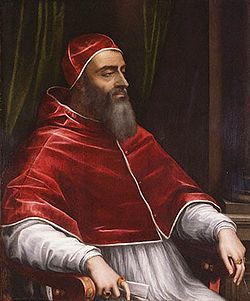 |
Clement VII Pope Clement VII Clement VII , born Giulio di Giuliano de' Medici, was a cardinal from 1513 to 1523 and was Pope from 1523 to 1534.-Early life:... |
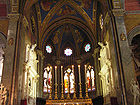 |
Nanni di Baccio Bigio Nanni di Baccio Bigio Nanni di Baccio Bigio, a pseudonym of Giovanni Lippi , was an Italian architect of the 16th century.Nanni was described as a "versatile" architect, who had originally set out to be a sculptor working under Raffaello da Montelupo. After arriving in Rome, he made a good copy of Michelangelo's Pietà... |
Santa Maria sopra Minerva | Originally buried in a brick tomb in Old St. Peter's; tomb is across from that of Leo X, another Medici pope (Leo X left, Clement VII right) |
| 13 October 1534 – 10 November 1549 | 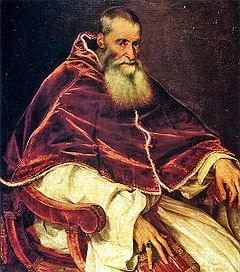 |
Paul III Pope Paul III Pope Paul III , born Alessandro Farnese, was Pope of the Roman Catholic Church from 1534 to his death in 1549. He came to the papal throne in an era following the sack of Rome in 1527 and rife with uncertainties in the Catholic Church following the Protestant Reformation... |
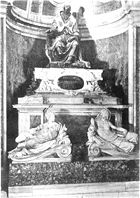 |
Guglielmo della Porta Guglielmo della Porta Guglielmo della Porta was an Italian architect and sculptor of the late-Renaissance or Mannerist period.He was born to a prominent North Italian family of masons, sculptors and architects. His father Giovanni Battista della Porta was a sculptor. He trained in his uncle's workshop in Genoa and... |
St. Peter's Basilica | Moved in 1599 |
| 7 February 1550 – 29 March 1555 | 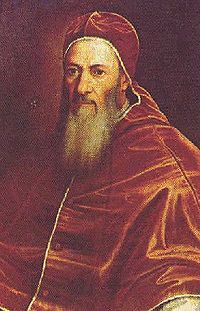 |
Julius III Pope Julius III Pope Julius III , born Giovanni Maria Ciocchi del Monte, was Pope from 7 February 1550 to 1555.... |
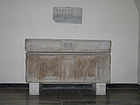 |
Unknown | St. Peter's Basilica | Originally buried in St. Peter's Basilica sans monument in a red stone sarcophagus in the chapel of San Andrea; reinterred in an ancient sarcophagus in 1608, which was reopened two years later during the demolition of Old St. Peter's; sometimes cited as buried in the Del Monte chapel of San Pietro in Montorio San Pietro in Montorio San Pietro in Montorio is a church in Rome, Italy, which includes in its courtyard The Tempietto built by Donato Bramante.-History:... along with his adopted cardinal-nephew Cardinal-nephew A cardinal-nephew is a cardinal elevated by a Pope who is that cardinal's uncle, or, more generally, his relative. The practice of creating cardinal-nephews originated in the Middle Ages, and reached its apex during the 16th and 17th centuries. The word nepotism originally referred specifically to... , Innocenzo Ciocchi Del Monte Innocenzo Ciocchi Del Monte Innocenzo Ciocchi Del Monte was a 16th century Cardinal, and the centre of scandal in his time. He was raised to his position at the age of 17 by the newly-elected Del Monte Pope Julius III, with whom he had been living for some years; he proved totally unsuited to hold office, and his continuing... |
| 9 April 1555 – 30 April or 1 May 1555 | 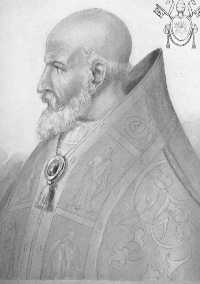 |
Marcellus II Pope Marcellus II Pope Marcellus II , born Marcello Cervini degli Spannochi, was Pope from 9 April 1555 to 1 May 1555, succeeding Pope Julius III. Before his accession as Pope he had been Cardinal-Priest of Santa Croce in Gerusalemme. He is the most recent Pope to choose to retain his birth name as his regnal name... |
 |
Unknown | St. Peter's Basilica | No monument; fourth century sarcophagus, bearing a traditio legis Christ in Majesty Christ in Majesty, or Christ in Glory, in Latin Majestas Domini, is the Western Christian image of Christ seated on a throne as ruler of the world, always seen frontally in the centre of the composition, and often flanked by other sacred figures, whose membership changes over time and according to... |
| 23 May 1555 – 18 August 1559 |  |
Paul IV Pope Paul IV Pope Paul IV, C.R. , né Giovanni Pietro Carafa, was Pope from 23 May 1555 until his death.-Early life:Giovanni Pietro Carafa was born in Capriglia Irpina, near Avellino, into a prominent noble family of Naples... |
 |
Pirro Ligorio Pirro Ligorio Pirro Ligorio was an Italian architect, painter, antiquarian and garden designer.-Biography:Ligorio was born in Naples. In 1534 he moved to Rome, where he developed his interest in antiquities, and was named superintendent to the ancient monuments by the Popes Pius IV and Paul IV... (design) Giacomo da Castignola, Tommaso della Porta, Gian Pietro Annon, and Rocco da Montefiascone (sculpted) |
Santa Maria sopra Minerva | |
| 26 December 1559 – 9 December 1565 |  |
Pius IV Pope Pius IV Pope Pius IV , born Giovanni Angelo Medici, was Pope from 1559 to 1565. He is notable for presiding over the culmination of the Council of Trent.-Biography:... |
 |
Unknown | Santa Maria degli Angeli e dei Martiri Santa Maria degli Angeli e dei Martiri The Basilica of St. Mary of the Angels and the Martyrs is a titular basilica church in Rome, built inside the frigidarium of the Baths of Diocletian. The Cardinal priest of the is William Henry Keeler.- The basilica :... |
Moved from Old St. Peter's in 1583; buried under the altar with a nearby wall plaque |
| 7 January 1566 – 1 May 1572 | 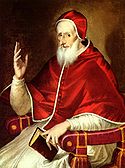 |
Pius V Pope Pius V Pope Saint Pius V , born Antonio Ghislieri , was Pope from 1566 to 1572 and is a saint of the Catholic Church. He is chiefly notable for his role in the Council of Trent, the Counter-Reformation, and the standardization of the Roman liturgy within the Latin Church... , O.P. Dominican Order The Order of Preachers , after the 15th century more commonly known as the Dominican Order or Dominicans, is a Catholic religious order founded by Saint Dominic and approved by Pope Honorius III on 22 December 1216 in France... Saint Pius |
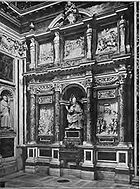 |
Dominico Fontana (design) Leonardo Sormani Leonardo Sormani Leonardo Sormani was an Italian sculptor of secondary reputation, originally from Savona, who is recorded as living in Rome from the 1550s until about 1590... (effigy) Nicholas Cordier (left and right bas-reliefs) Silla Longhi da Viggiu (center bas-relief) |
Basilica di Santa Maria Maggiore | Translated from Old St. Peter's in 1583 |
| 13 May 1572 – 10 April 1585 | 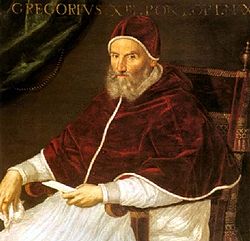 |
Gregory XIII Pope Gregory XIII Pope Gregory XIII , born Ugo Boncompagni, was Pope from 1572 to 1585. He is best known for commissioning and being the namesake for the Gregorian calendar, which remains the internationally-accepted civil calendar to this date.-Youth:He was born the son of Cristoforo Boncompagni and wife Angela... |
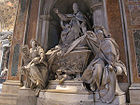 |
Camillo Rusconi Camillo Rusconi Camillo Rusconi was an Italian sculptor of the late Baroque in Rome. His style displays both features of Baroque and Neoclassicism. He has been described as a Carlo Maratta in marble.-Biography:... |
St. Peter's Basilica | Original monument destroyed; new monument built in eighteenth century |
| 24 April 1585 – 27 August 1590 | 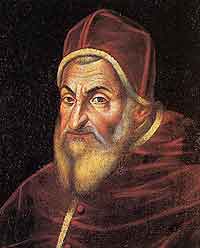 |
Sixtus V Pope Sixtus V Pope Sixtus V , born Felice Peretti di Montalto, was Pope from 1585 to 1590.-Early life:The chronicler Andrija Zmajević states that Felice's family originated from modern-day Montenegro... , O.F.M. Conv. Conventual Franciscans The Order of Friars Minor Conventual , commonly known as the Conventual Franciscans, is a branch of the order of Catholic Friars founded by Francis of Assisi in 1209.-History:... |
 |
Domenico Fontana Domenico Fontana Domenico Fontana was a Swiss-born Italian architect of the late Renaissance.-Biography:200px|thumb|Fountain of Moses in Rome.... (design) Vasoldo (sculpted) |
Basilica di Santa Maria Maggiore | |
| 15 September 1590 – 27 September 1590 | 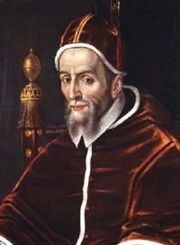 |
Urban VII Pope Urban VII Pope Urban VII , born Giovanni Battista Castagna, was Pope for thirteen days in September 1590. He was of Genoese origin, although born in Rome. He was created Cardinal-Priest of S. Marcello in 1584... |
 |
Ambrogio Buonvicino | Santa Maria sopra Minerva | |
| 5 December 1590 – 15 /16 October 1591 | 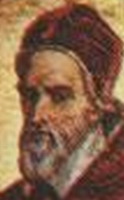 |
Gregory XIV Pope Gregory XIV Pope Gregory XIV , born Niccolò Sfondrati, was Pope from 5 December 1590 until his death in 1591.- Early career :... |
Prospero Antichi | St. Peter's Basilica | ||
| 29 October 1591 – 30 December 1591 | 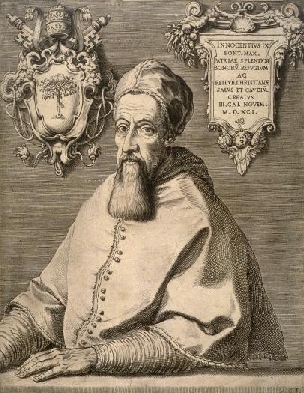 |
Innocent IX Pope Innocent IX Pope Innocent IX , born Giovanni Antonio Facchinetti, was Pope from 29 October 1591 to his death on 30 December of the same year... |
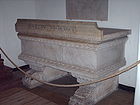 |
Unknown | St. Peter's Basilica | No monument |
| 30 January 1592 – 3 March 1605 |  |
Clement VIII Pope Clement VIII Pope Clement VIII , born Ippolito Aldobrandini, was Pope from 30 January 1592 to 3 March 1605.-Cardinal:... |
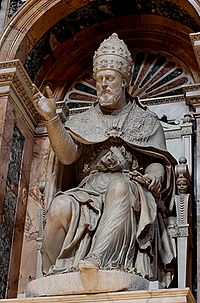 |
Flaminio Ponzio Flaminio Ponzio Flaminio Ponzio was an Italian architect during the late-Renaissance or so-called Mannerist period, serving in Rome as the architect for Pope Paul V.Ponzio was born in Viggiù near Varese, and he died in Rome... (design) |
Basilica di Santa Maria Maggiore | Moved in 1646 to the Borghese Crypt in the Paulline Chapel in Santa Maria Maggiore; figure of Clement VIII was carved by Silla da Viggiu and the cornice figures by Pietro Bernini Pietro Bernini Pietro Bernini was an Italian sculptor. He was the father of one the most famous artists of Baroque, Gian Lorenzo Bernini.... ; features "The Peace of Henry IV and Philip III by Ippolito Buzi and "The Coronation of Clement VIII" by Bernini, "The Canonization of St. Giacinto and St. Raimondo" by Giovanni Antonio Valsolde, "The Occupation of Ferrara" by Ambriogo Bonvicino, and "Invitation of the Troops in Hungary" by Camillo Mariani Camillo Mariani Camillo Mariani was an Italian sculptor of the early Baroque.He was born in Vicenza. He apprenticed in the studio of the prominent Venetian Mannerist sculptor Alessandro Vittoria, but moved to Rome in 1597. His first works in Rome were stucco statuary for the churches of San Bernardo alle Terme ... |
17th century
| Pontificate | Portrait | Common English name | Image | Sculptor | Location | Notes |
|---|---|---|---|---|---|---|
| 1 April 1605 – 27 April 1605 | 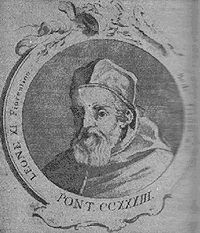 |
Leo XI Pope Leo XI Pope Leo XI , born Alessandro Ottaviano de' Medici, was Pope from 1 April 1605 to 27 April of the same year.-Biography:... |
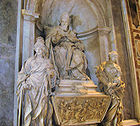 |
Alessandro Algardi Alessandro Algardi Alessandro Algardi was an Italian high-Baroque sculptor active almost exclusively in Rome, where for the latter decades of his life, he was the major rival of Gian Lorenzo Bernini.-Early years:... (pope and sarcophagus) Ercole Ferrata Ercole Ferrata Ercole Ferrata was an Italian sculptor of the Roman Baroque.-Biography:A native of Pellio Inferiore, near Como, Ferrata initially apprenticed with Alessandro Algardi, and became one of his prime assistants... (Prudence) Giuseppe Peroni Giuseppe Peroni Giuseppe Peroni was an Italian painter of the Baroque period.He was born in Parma, but studied in Bologna as an apprentice of the painters Felice Torelli and Donato Creti, then moved to Rome to work with Agostino Masucci. He painted in the pre-eminent style of his time, the grand manner of Carlo... (Liberty) |
St. Peter's Basilica | |
| 16 May 1605 – 28 January 1621 | 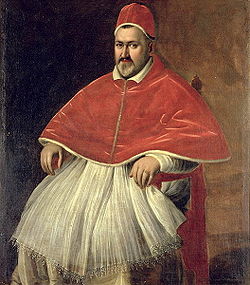 |
Paul V Pope Paul V -Theology:Paul met with Galileo Galilei in 1616 after Cardinal Bellarmine had, on his orders, warned Galileo not to hold or defend the heliocentric ideas of Copernicus. Whether there was also an order not to teach those ideas in any way has been a matter for controversy... |
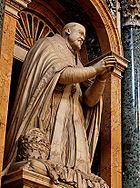 |
Flaminio Ponzio Flaminio Ponzio Flaminio Ponzio was an Italian architect during the late-Renaissance or so-called Mannerist period, serving in Rome as the architect for Pope Paul V.Ponzio was born in Viggiù near Varese, and he died in Rome... (design) Silla da Viggiu (figure of pope) Stefano Moderna, Ambrogio Bonvicinio, Ippolito Buzi, Cristoforo Stati, and Antonio Valsoldo (reliefs) Pompeo Ferucci (cornice figures) |
Basilica di Santa Maria Maggiore Basilica di Santa Maria Maggiore The Papal Basilica of Saint Mary Major , known also by other names, is the largest Roman Catholic Marian church in Rome, Italy.There are other churches in Rome dedicated to Mary, such as Santa Maria in Trastevere, Santa Maria in Aracoeli, Santa Maria sopra Minerva, but the greater size of the... |
Moved from the Borghese Chapel of St. Peter's to the Pauline chapel of Santa Maria Maggiore |
| 9 February 1621 – 8 July 1623 | 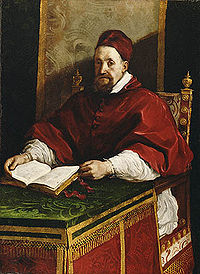 |
Gregory XV Pope Gregory XV Pope Gregory XV , born Alessandro Ludovisi, was pope from 1621, succeeding Paul V on 9 February 1621... |
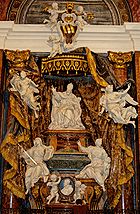 |
Orazio Grassi Orazio Grassi Orazio Grassi was an Italian mathematician, astronomer and architect.Canonical pertaining to Society of Jesus, he was one of the authors in controversy with Galileo Galilei on the nature of the comets.... (design) Pierre Le Gros the Younger Pierre Le Gros the Younger Pierre Le Gros was a French sculptor, active almost exclusively in Baroque Rome. Nowadays, his name is commonly written Legros, while he himself always signed as Le Gros; he is frequently referred to either as 'the Younger' or 'Pierre II' to distinguish him from his father, Pierre Le Gros the... , Pierre-Étienne Monnot Pierre-Étienne Monnot Pierre-Étienne Monnot was a French sculptor working mostly in Rome in a late-Baroque idiom.Monnot was born at Orchamps-Vennes, Doubs, Franche-Comté, and brought up at Besançon. Trained at first by his father, he was apprenticed to a sculptor at Dijon, then developed his style during a decade in... , and Camillo Rusconi Camillo Rusconi Camillo Rusconi was an Italian sculptor of the late Baroque in Rome. His style displays both features of Baroque and Neoclassicism. He has been described as a Carlo Maratta in marble.-Biography:... (sculpted) |
Sant'Ignazio Sant'Ignazio The Church of Saint Ignatius of Loyola at Campus Martius is Roman Catholic titular church dedicated to Ignatius of Loyola, the founder of the Jesuit order, located in Rome, Italy... |
Buried with his cardinal-nephew Cardinal-nephew A cardinal-nephew is a cardinal elevated by a Pope who is that cardinal's uncle, or, more generally, his relative. The practice of creating cardinal-nephews originated in the Middle Ages, and reached its apex during the 16th and 17th centuries. The word nepotism originally referred specifically to... , Ludovico Ludovisi; moved from the Quirinal Palace Quirinal Palace The Quirinal Palace is a historical building in Rome, Italy, the current official residence of the President of the Italian Republic. It is located on the Quirinal Hill, the tallest of the seven hills of Rome... in 1634 |
| 6 August 1623 – 29 July 1644 | Urban VIII Pope Urban VIII Pope Urban VIII , born Maffeo Barberini, was pope from 1623 to 1644. He was the last pope to expand the papal territory by force of arms, and was a prominent patron of the arts and reformer of Church missions... |
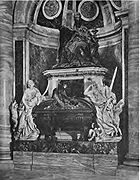 |
Gian Lorenzo Bernini Gian Lorenzo Bernini Gian Lorenzo Bernini was an Italian artist who worked principally in Rome. He was the leading sculptor of his age and also a prominent architect... |
St. Peter's Basilica | ||
| 15 September 1644 – 7 January 1655 |  |
Innocent X Pope Innocent X Pope Innocent X , born Giovanni Battista Pamphilj , was Pope from 1644 to 1655. Born in Rome of a family from Gubbio in Umbria who had come to Rome during the pontificate of Pope Innocent IX, he graduated from the Collegio Romano and followed a conventional cursus honorum, following his uncle... |
 |
G. Valvassori and G.B. Maini | Sant'Agnese in Agone Sant'Agnese in Agone Sant'Agnese in Agone is a seventeenth century Baroque church in Rome, Italy. It faces onto the Piazza Navona, one of the main urban spaces in the historic centre of the city and the site where the Early Christian Saint Agnes was martyred in the ancient Stadium of Domitian.The rebuilding of the... |
Cenotaph featuring the Virtues (left) and Strength (right) erected in 1730 |
| 7 April 1655 – 22 May 1667 |  |
Alexander VII Pope Alexander VII Pope Alexander VII , born Fabio Chigi, was Pope from 7 April 1655, until his death.- Early life :Born in Siena, a member of the illustrious banking family of Chigi and a great-nephew of Pope Paul V , he was privately tutored and eventually received doctorates of philosophy, law, and theology from... |
Gian Lorenzo Bernini Gian Lorenzo Bernini Gian Lorenzo Bernini was an Italian artist who worked principally in Rome. He was the leading sculptor of his age and also a prominent architect... (monument) Michele Maglia (figure of pope) Giuseppe Mazzuoli (Charity) Lazzaro Morelli Lazzaro Morelli Lazzaro Morelli was an Italian sculptor of the Baroque period. Born in Ascoli Piceno, the son of the Florentine sculptor Fulgenzio Morelli, who also trained Lazzaro's cousin, the artist Giuseppe Giosafatti... and Giulio Catani (Truth) Giuseppe Baratta and Giulio Cartari (Prudence) Giulio Catani (Justice) |
St. Peter's Basilica | Sculpted between 1672 and 1678; Charity's breast's covered by Innocent XI See Tomb of Pope Alexander VII Tomb of Pope Alexander VII The tomb of Alexander VII is a sculptural monument designed and partially executed by the Italian artist Gianlorenzo Bernini. It is in the basilica of St Peter's in the Vatican City.... |
|
| 20 June 1667 – 9 December 1669 |  |
Clement IX Pope Clement IX Pope Clement IX , born Giulio Rospigliosi, was Pope from 1667 to 1669.-Early life:Born Giulio Rospigliosi to a noble family of Pistoia, Grand Duchy of Tuscany, he was a pupil of the Jesuits. After receiving his doctorate in philosophy at the University of Pisa, he taught theology there... |
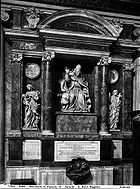 |
Ercole Ferrata Ercole Ferrata Ercole Ferrata was an Italian sculptor of the Roman Baroque.-Biography:A native of Pellio Inferiore, near Como, Ferrata initially apprenticed with Alessandro Algardi, and became one of his prime assistants... |
Basilica di Santa Maria Maggiore | Moved from St. Peter's in 1675; figures are Clement IX (by Girolamo Rainaldi Girolamo Rainaldi Girolamo Rainaldi was an Italian architect who worked on the whole in a conservative Mannerist style, often with collaborating architects, yet was a successful competitor of Bernini... ), Charity (by Ferrata), and Truth (by Cosimo Fancelli Cosimo Fancelli Cosimo Fancelli was an Italian sculptor of the Baroque period, active mainly in Rome. He was the son of the artist Carlo Fancelli from Arezzo. Like his brother, the sculptor Giacomo Antonio Fancelli, he began his career as an assistant in the studio of Bernini... ) |
| 29 April 1670 – 22 July 1676 | 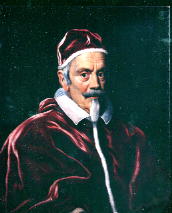 |
Clement X Pope Clement X Pope Clement X , born Emilio Bonaventura Altieri, was Pope from 29 April 1670 to 22 July 1676.-Early life:Emilio Altieri was born in Rome, the son of Lorenzo Altieri and Victoria Delphini, a Venetian lady... |
 |
Mattia de' Rossi (design) | St. Peter's Basilica | Figures are Clement X (by Ercole Ferrata Ercole Ferrata Ercole Ferrata was an Italian sculptor of the Roman Baroque.-Biography:A native of Pellio Inferiore, near Como, Ferrata initially apprenticed with Alessandro Algardi, and became one of his prime assistants... ), Clemency (by Giuseppe Mazzuoli), Goodness (by Lazzaro Morelli Lazzaro Morelli Lazzaro Morelli was an Italian sculptor of the Baroque period. Born in Ascoli Piceno, the son of the Florentine sculptor Fulgenzio Morelli, who also trained Lazzaro's cousin, the artist Giuseppe Giosafatti... ), and two putti (by Filippo Carcani) |
| 21 September 1676 – 11/12 August 1689 | 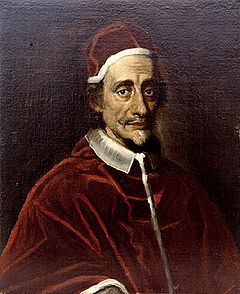 |
Innocent XI Pope Innocent XI Blessed Pope Innocent XI , born Benedetto Odescalchi, was Pope from 1676 to 1689.-Early life:Benedetto Odescalchi was born at Como in 1611 , the son of a Como nobleman, Livio Odescalchi, and Paola Castelli Giovanelli from Gandino... Blessed Innocent XI |
 |
C. Maratta (design) Pierre Etienne Monnot (sculpted) |
St. Peter's Basilica | Featured the pope with the Virtue Truth and the Goddess Athena; bas-relief on the sarcophagus reads "The Liberation of Vienna" |
 |
Unknown | Separate glass sarcophagus moved under the altar of the Transfiguration after his body was removed from the altar of Saint Sebastian on 2011 | ||||
| 6 October 1689 – 1 February 1691 |  |
Alexander VIII Pope Alexander VIII Pope Alexander VIII , born Pietro Vito Ottoboni, was Pope from 1689 to 1691.-Early life:Pietro Ottoboni was born of a noble Venetian family, and was the son of Marco Ottoboni, chancellor of the Republic of Venice... |
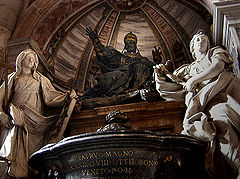 |
Angelo de Rossi Angelo de Rossi Angelo de Rossi was an Italian sculptor. Born in Genoa, he was apprenticed to Filippo Parodi in 1680; Parodi's influence is clear in his first pre-1689 work, a Small Satyr in marble... |
St. Peter's Basilica | |
| 12 July 1691 – 27 September 1700 | 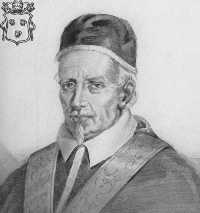 |
Innocent XII Pope Innocent XII Pope Innocent XII , born Antonio Pignatelli, was Pope from 1691 to 1700.-Biography:He was born in Spinazzola to one of the most aristocratic families of the Kingdom of Naples, which included many Viceroys, and ministers to the crown, and was educated at the Jesuit college in Rome.In his twentieth... |
Filippo della Valle Filippo della Valle Filippo della Valle was an Italian late-Baroque or early Neoclassic sculptor, active mostly in Rome.-Biography:Della Valle was born in Florence.... and Ferdinando Fuga Ferdinando Fuga Ferdinando Fuga was an Italian architect, whose main works were realized in Rome and Naples in the Baroque style.-Biography:Born in Florence, he began to work in that city as a pupil of Giovanni Battista Foggini. In 1717 he moved to Rome, to continue his apprentice studies... |
St. Peter's Basilica | Moved from the tribune to the left transept in the late eighteenth century by Cardinal Giuseppe Spinelli; originally buried in a simple marble sarcophagus in the Chapel of the Sacrament; present monument completed in 1746; features the pope bestowing the benediction with Charity (left) and Justice (right) | |
| 23 November 1700 – 19 March 1721 |  |
Clement XI Pope Clement XI Pope Clement XI , born Giovanni Francesco Albani, was Pope from 1700 until his death in 1721.-Early life:... |
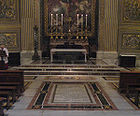 |
Carlo Fontana Carlo Fontana Carlo Fontana was an Italian architect, who was in part responsible for the classicizing direction taken by Late Baroque Roman architecture.-Biography:... |
St. Peter's Basilica | In the Choro chapel; no monument; cenotaph also placed in Ferrara Cathedral Ferrara Cathedral Ferrara Cathedral is a basilica in Ferrara, Northern Italy, the largest religious edifice in the city... |
18th century
| Pontificate | Portrait | Common English name | Image | Sculptor | Location | Notes |
|---|---|---|---|---|---|---|
| 8 May 1721 – 7 March 1724 |  |
Innocent XIII Pope Innocent XIII Pope Innocent XIII was pope from 1721 until his death.He was born Michelangelo Conti in Poli, near Rome. Like Pope Innocent III , Pope Gregory IX and Pope Alexander IV , he was a member of the family of the Conti, counts and dukes of Segni... |
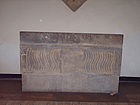 |
Unknown | St. Peter's Basilica | Originally buried in a stucco sepulcher in the right nave of St. Peter's; reinterred in an ancient sarcophagus in 1836 |
| 29 May 1724 – 21 February 1730 | 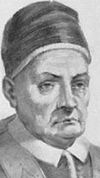 |
Benedict XIII Pope Benedict XIII -Footnotes:... , O.P. Dominican Order The Order of Preachers , after the 15th century more commonly known as the Dominican Order or Dominicans, is a Catholic religious order founded by Saint Dominic and approved by Pope Honorius III on 22 December 1216 in France... |
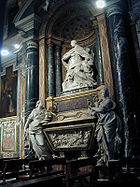 |
Pietro Bracci Pietro Bracci Pietro Bracci was an Italian sculptor working in the Late Baroque manner.-Biography:He was born in Rome and became a student of Giuseppe Bartolomeo Chiari and Camillo Rusconi... and Carlo Marchionni Carlo Marchionni Carlo Marchionni was an Italian architect. He was also a sculptor and a virtuoso draughtsman, who mixed in the artistic and intellectual circles.-Biography:Marchionni was born in Rome.... |
Santa Maria sopra Minerva Santa Maria sopra Minerva The Basilica of Saint Mary Above Minerva is a titular minor basilica and one of the most important churches of the Roman Catholic Dominican order in Rome, Italy. The church, located in the Piazza della Minerva in the Campus Martius region, is considered the only Gothic church in Rome. It houses... |
Remains were originally with his monument in St. Peter's Basilica |
| 12 July 1730 – 6 February 1740 | 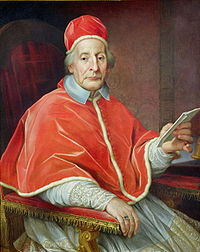 |
Clement XII Pope Clement XII Pope Clement XII , born Lorenzo Corsini, was Pope from 12 July 1730 to 6 February 1740.Born in Florence, the son of Bartolomeo Corsini, Marquis of Casigliano and his wife Isabella Strozzi, sister of the Duke of Bagnuolo, Corsini had been an aristocratic lawyer and financial manager under preceding... |
 |
Giovanni Battista Maini Giovanni Battista Maini Giovanni Battista Maini was an Italian sculptor of the Late-Baroque period, active mainly in Rome.He was born in Cassano Magnago in Lombardy, and died in Rome. He may have had contacts with Foggini in Florence. By 1708, he had moved to Rome where he joined the large studio of Camillo Rusconi,... |
Basilica of St. John Lateran Basilica of St. John Lateran The Papal Archbasilica of St. John Lateran , commonly known as St. John Lateran's Archbasilica and St. John Lateran's Basilica, is the cathedral of the Diocese of Rome and the official ecclesiastical seat of the Bishop of Rome, who is the Pope... |
|
| 17 August 1740 – 3 May 1758 | 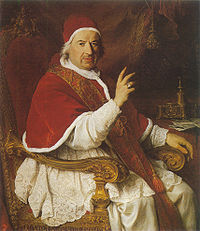 |
Benedict XIV Pope Benedict XIV Pope Benedict XIV , born Prospero Lorenzo Lambertini, was Pope from 17 August 1740 to 3 May 1758.-Life:... |
 |
Pietro Bracci Pietro Bracci Pietro Bracci was an Italian sculptor working in the Late Baroque manner.-Biography:He was born in Rome and became a student of Giuseppe Bartolomeo Chiari and Camillo Rusconi... |
St. Peter's Basilica | Two figures are Knowledge (by Bracci) and Temptation (by Gaspare Sibilla) |
| 6 July 1758 – 2 February 1769 | 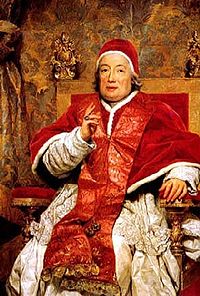 |
Clement XIII Pope Clement XIII Pope Clement XIII , born Carlo della Torre di Rezzonico, was Pope from 16 July 1758 to 2 February 1769.... |
 |
Antonio Canova Antonio Canova Antonio Canova was an Italian sculptor from the Republic of Venice who became famous for his marble sculptures that delicately rendered nude flesh... |
St. Peter's Basilica | |
| 19 May 1769 – 22 September 1774 |  |
Clement XIV Pope Clement XIV Pope Clement XIV , born Giovanni Vincenzo Antonio Ganganelli, was Pope from 1769 to 1774. At the time of his election, he was the only Franciscan friar in the College of Cardinals.-Early life:... , O.F.M. Conv. Conventual Franciscans The Order of Friars Minor Conventual , commonly known as the Conventual Franciscans, is a branch of the order of Catholic Friars founded by Francis of Assisi in 1209.-History:... |
 |
Antonio Canova Antonio Canova Antonio Canova was an Italian sculptor from the Republic of Venice who became famous for his marble sculptures that delicately rendered nude flesh... |
Santi Apostoli Santi Apostoli The Church of the Twelve Holy Apostles is a 6th century Roman Catholic parish and titular church and minor basilica in Rome, Italy, dedicated originally to St. James and St. Philip and later to all Apostles... |
Moved to Santi Apostoli in 1802 |
| 15 February 1775 – 29 August 1799 |  |
Pius VI Pope Pius VI Pope Pius VI , born Count Giovanni Angelo Braschi, was Pope from 1775 to 1799.-Early years:Braschi was born in Cesena... |
 |
Antonio Canova Antonio Canova Antonio Canova was an Italian sculptor from the Republic of Venice who became famous for his marble sculptures that delicately rendered nude flesh... |
St. Peter's Basilica | Monument by Antonio Canova, circa 1822 |
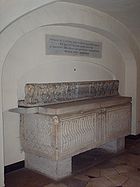 |
Unknown | Remains placed in an ancient sarcophagus with a bas-relief of the Adoration of the Magi by Pius XII in 1949 (below); original praecordia monument in the Valence Cathedral Valence Cathedral Valence Cathedral is a Roman Catholic cathedral in Valence, Drôme, dedicated to Saint Apollinaris of Valence.It is the seat of the Bishop of Valence.... sculpted by Massimiliano Laboureur and commissioned by Napoleon |
||||
| 14 March 1800 – 20 August 1823 |  |
Pius VII Pope Pius VII Pope Pius VII , born Barnaba Niccolò Maria Luigi Chiaramonti, was a monk, theologian and bishop, who reigned as Pope from 14 March 1800 to 20 August 1823.-Early life:... , O.S.B. Order of Saint Benedict The Order of Saint Benedict is a Roman Catholic religious order of independent monastic communities that observe the Rule of St. Benedict. Within the order, each individual community maintains its own autonomy, while the organization as a whole exists to represent their mutual interests... |
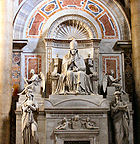 |
Bertel Thorvaldsen Bertel Thorvaldsen Bertel Thorvaldsen was a Danish-Icelandic sculptor of international fame, who spent most of his life in Italy . Thorvaldsen was born in Copenhagen into a Danish/Icelandic family of humble means, and was accepted to the Royal Academy of Arts when he was eleven years old... |
St. Peter's Basilica | Commissioned at the expense of Cardinal Consalvi, Pius VII's Secretary of State; depicts the pope blessing the angels of Time and History, with the onlooking figures of Wisdom (left) and Strength (right) |
19th century
| Pontificate | Portrait | Common English name | Image | Sculptor | Location | Notes |
|---|---|---|---|---|---|---|
| 28 September 1823 – 10 February 1829 | 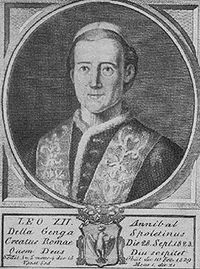 |
Leo XII Pope Leo XII Pope Leo XII , born Annibale Francesco Clemente Melchiore Girolamo Nicola Sermattei della Genga, was Pope from 1823 to 1829.-Life:... |
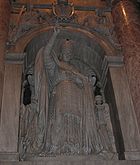 |
Giuseppe Fabris | St. Peter's Basilica | |
| 31 March 1829 – 1 December 1830 |  |
Pius VIII Pope Pius VIII Pope Pius VIII , born Francesco Saverio Castiglioni was Pope in 1829 and 1830.-Biography:He was born in Cingoli, Marche, the son of Count Ottavio Castiglioni and his wife Sanzia Ghislieri. He studied Canon law and, in 1800 became bishop of Montalto... |
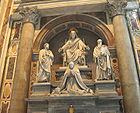 |
Pietro Tenerani Pietro Tenerani Pietro Tenerani was an Italian sculptor who studied in the studios of both Antonio Canova and Bertel Thorvaldsen and carried a chaste neoclassical style into the mid-nineteenth century, specialising in pious subjects. His most prominent commission was for the tomb of Pope Pius VIII in Rome.... |
St. Peter's Basilica | Moved from the Vatican grottoes in 1857 to the Tenerani monument commissioned by Cardinal Albani; figures are the kneeling pontiff and seated Christ as well as Saints Peter (left) and Paul (right); base reliefs are Prudence (left) and Justice (right) |
| 2 February 1831 – 1 June 1846 |  |
Gregory XVI Pope Gregory XVI Pope Gregory XVI , born Bartolomeo Alberto Cappellari, named Mauro as a member of the religious order of the Camaldolese, was Pope of the Catholic Church from 1831 to 1846... , O.S.B. Cam. Camaldolese The Camaldolese monks and nuns are part of the Benedictine family of monastic communities which follow the way of life outlined in the Rule of St. Benedict, written in the 6th century... |
 |
Luigi Amici | St. Peter's Basilica | |
| 16 June 1846 – 7 February 1878 |  |
Pius IX Pope Pius IX Blessed Pope Pius IX , born Giovanni Maria Mastai-Ferretti, was the longest-reigning elected Pope in the history of the Catholic Church, serving from 16 June 1846 until his death, a period of nearly 32 years. During his pontificate, he convened the First Vatican Council in 1869, which decreed papal... Blessed Pius IX |
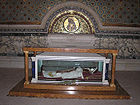 |
Unknown | San Lorenzo fuori le Mura San Lorenzo fuori le Mura The Papal Basilica of Saint Lawrence outside the Walls is a Roman Catholic parish church and minor basilica, located in Rome, Italy. The basilica is one of the Seven Pilgrim Churches of Rome and one of the five Patriarchal basilicas, each of which is assigned to a patriarchate. St... |
|
| 20 February 1878 – 20 July 1903 |  |
Leo XIII Pope Leo XIII Pope Leo XIII , born Vincenzo Gioacchino Raffaele Luigi Pecci to an Italian comital family, was the 256th Pope of the Roman Catholic Church, reigning from 1878 to 1903... |
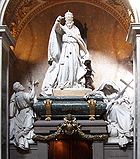 |
Giulio Tadolini Giulio Tadolini Giulio Tadolini was an Academic-trained Italian sculptor, who was born and died in Rome, where he passed his career in the family atelier, which he inherited from his uncle, Adamo Tadolini... |
Basilica of St. John Lateran Basilica of St. John Lateran The Papal Archbasilica of St. John Lateran , commonly known as St. John Lateran's Archbasilica and St. John Lateran's Basilica, is the cathedral of the Diocese of Rome and the official ecclesiastical seat of the Bishop of Rome, who is the Pope... |
Tomb monument |
20th century
| Pontificate | Portrait | Common English name | Image | Sculptor | Location | Notes |
|---|---|---|---|---|---|---|
| 4 August 1903 – 20 August 1914 | Pius X Pope Pius X Pope Saint Pius X , born Giuseppe Melchiorre Sarto, was the 257th Pope of the Catholic Church, serving from 1903 to 1914. He was the first pope since Pope Pius V to be canonized. Pius X rejected modernist interpretations of Catholic doctrine, promoting traditional devotional practices and orthodox... Saint Pius X |
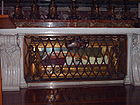 |
Pier Enrico Astorri and Florestano Di Fausto | St. Peter's Basilica | ||
| 3 September 1914 – 22 January 1922 |  |
Benedict XV Pope Benedict XV Pope Benedict XV , born Giacomo Paolo Giovanni Battista della Chiesa, reigned as Pope from 3 September 1914 to 22 January 1922... |
Pietro Canonica | St. Peter's Basilica | Original | |
 |
Giulio Barbieri (bronze effigy) | Current | ||||
| 6 February 1922 – 10 February 1939 |  |
Pius XI Pope Pius XI Pope Pius XI , born Ambrogio Damiano Achille Ratti, was Pope from 6 February 1922, and sovereign of Vatican City from its creation as an independent state on 11 February 1929 until his death on 10 February 1939... |
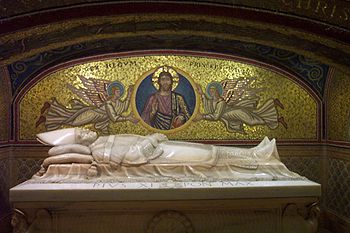 |
Giannino Castiglioni | St. Peter's Basilica | Candoglia marble sarcophagus topped with a deathbed effigy |
| 2 March 1939 – 9 October 1958 |  |
Pius XII Pope Pius XII The Venerable Pope Pius XII , born Eugenio Maria Giuseppe Giovanni Pacelli , reigned as Pope, head of the Catholic Church and sovereign of Vatican City State, from 2 March 1939 until his death in 1958.... Venerable Pius XII |
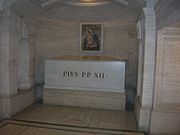 |
Francesco Messina Francesco Messina Francesco Messina , was an one of the most renowned Italian sculptors of the 20th century.-Biography and Career:Francesco Messina was born at Linguaglossa in the Province of Catania from a very poor family... (bronze funeral monument) |
St. Peter's Basilica | Funeral monument in St. Peter's separate from sarcophagus |
| 28 October 1958 – 3 June 1963 | 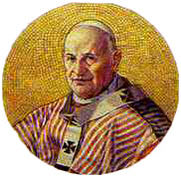 |
John XXIII Pope John XXIII -Papal election:Following the death of Pope Pius XII in 1958, Roncalli was elected Pope, to his great surprise. He had even arrived in the Vatican with a return train ticket to Venice. Many had considered Giovanni Battista Montini, Archbishop of Milan, a possible candidate, but, although archbishop... Blessed John XXIII |
.jpg) |
Emilio Greco Emilio Greco Emilio Greco was an Italian sculptor.Greco was born at Catania, whose Greek and Roman remains grow in him a passion for ancient sculpture. His first successful work was a "Pinocchio" at Collodi. He died in Rome in 1995. Throughout his career, his sculptures tend to be refined, with elongated... |
St. Peter's Basilica | |
| 21 June 1963 – 6 August 1978 | 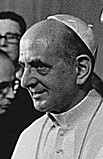 |
Paul VI Pope Paul VI Paul VI , born Giovanni Battista Enrico Antonio Maria Montini , reigned as Pope of the Catholic Church from 21 June 1963 until his death on 6 August 1978. Succeeding Pope John XXIII, who had convened the Second Vatican Council, he decided to continue it... Servant of God Paul VI |
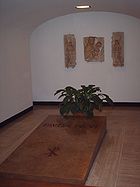 |
Unknown | St. Peter's Basilica | Three reliefs are from the fifteenth century; "as simple as possible [...] neither tomb nor monument" and buried in the ground per Paul VI's wishes |
| 26 August 1978 – 28 September 1978 | John Paul I Pope John Paul I John Paul I , born Albino Luciani, , reigned as Pope of the Catholic Church and as Sovereign of Vatican City from 26 August 1978 until his death 33 days later. His reign is among the shortest in papal history, resulting in the most recent Year of Three Popes... Servant of God John Paul I |
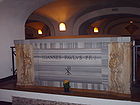 |
Francesco Vacchini (design) Andrea Bregno Andrea Bregno Andrea di Cristoforo Bregno was an Italian sculptor and architect of the Early Renaissance who worked in Rome from the 1460s and died just as the High Renaissance was getting under way.-Early life:... (reliefs) |
St. Peter's Basilica | Reliefs are late fifteenth century; across the aisle from Marcellus II, another short-reigning pope | |
| 16 October 1978 – 2 April 2005 | 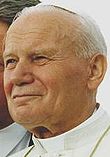 |
John Paul II Pope John Paul II Blessed Pope John Paul II , born Karol Józef Wojtyła , reigned as Pope of the Catholic Church and Sovereign of Vatican City from 16 October 1978 until his death on 2 April 2005, at of age. His was the second-longest documented pontificate, which lasted ; only Pope Pius IX ... Blessed John Paul II |
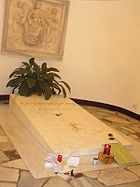 |
Unknown | St. Peter's Basilica | See Funeral of Pope John Paul II Funeral of Pope John Paul II The funeral of Pope John Paul II was held on 8 April 2005, six days after his death on 2 April. The funeral was followed by the novemdiales devotional in which the Roman Catholic Church and the Eastern Catholic Churches observe nine days of mourning.... His body was moved from the Vatican Grottoes to the chapel of Saint Sebastian after his Beatification on May 1st, 2011 |

